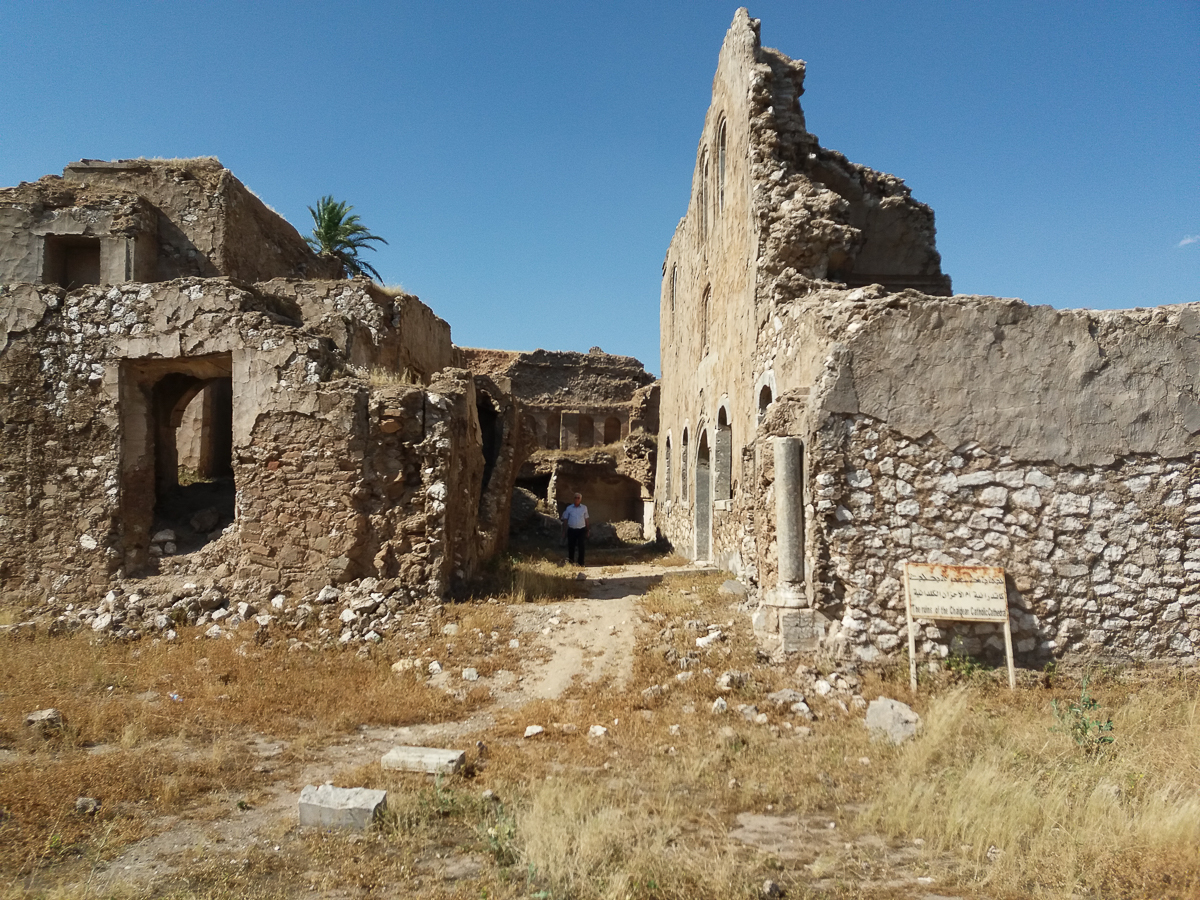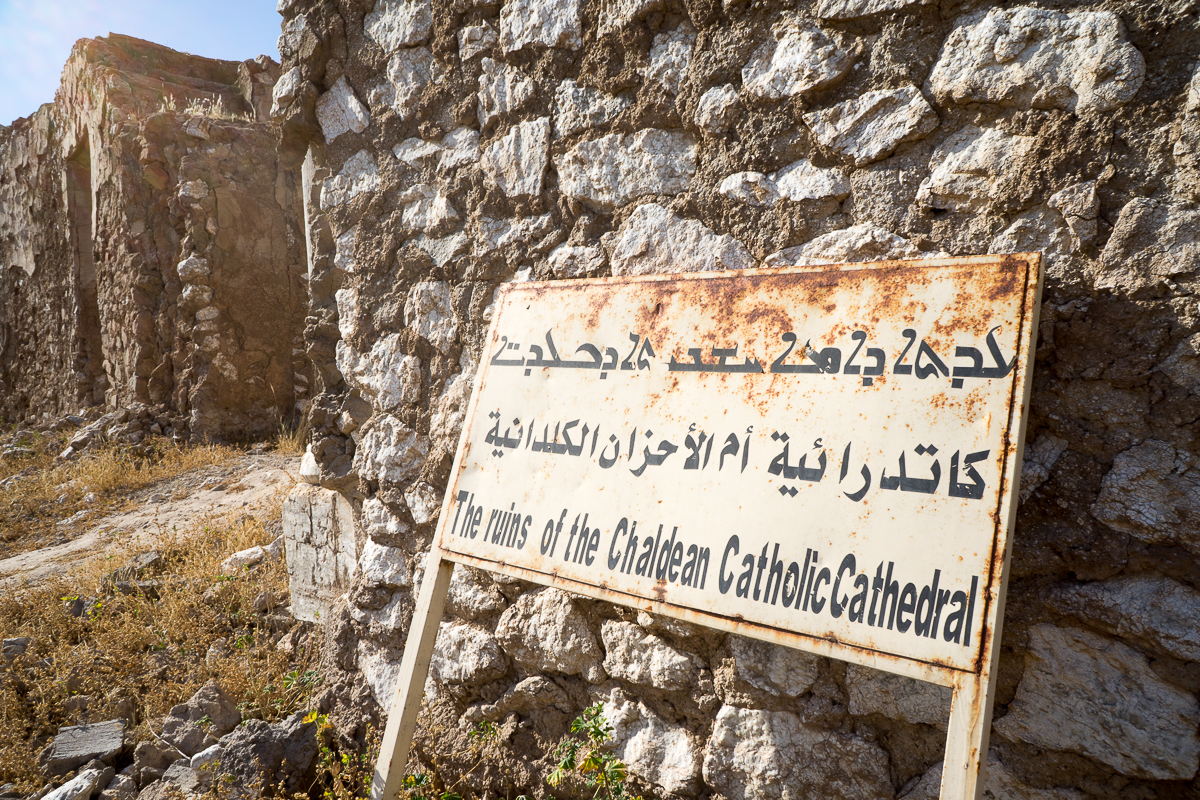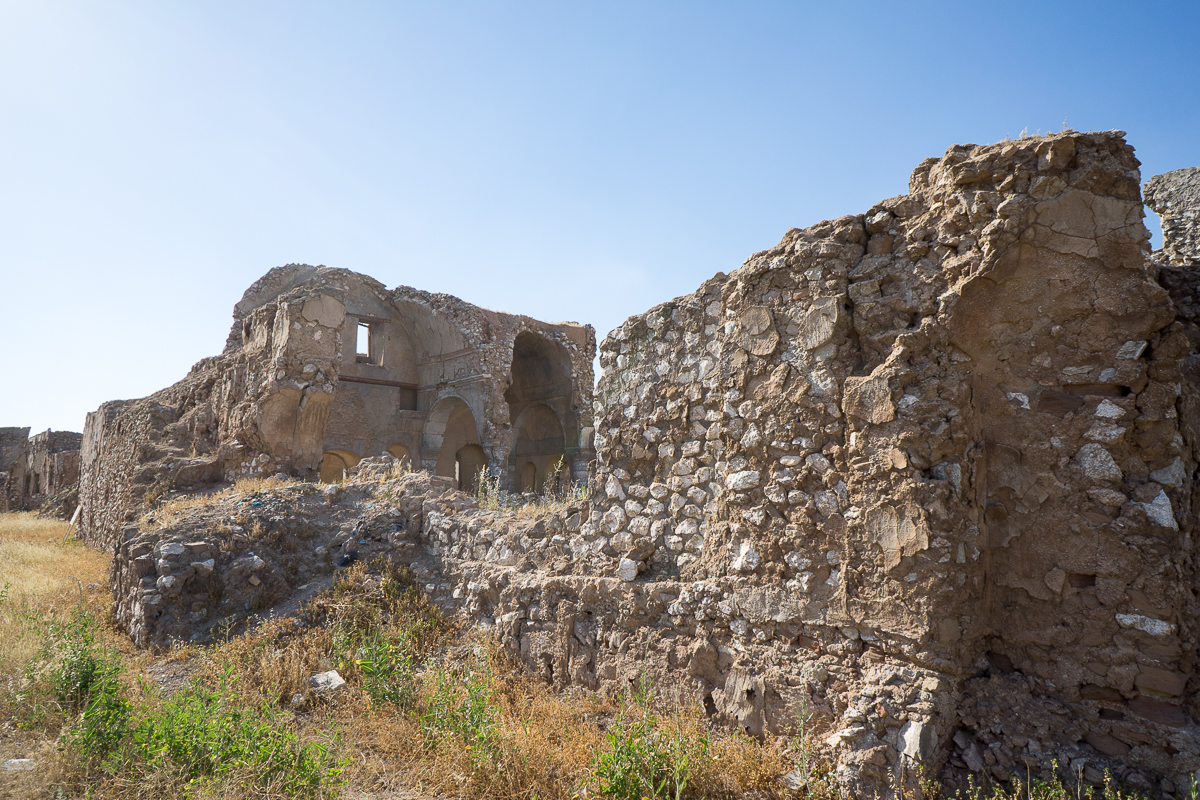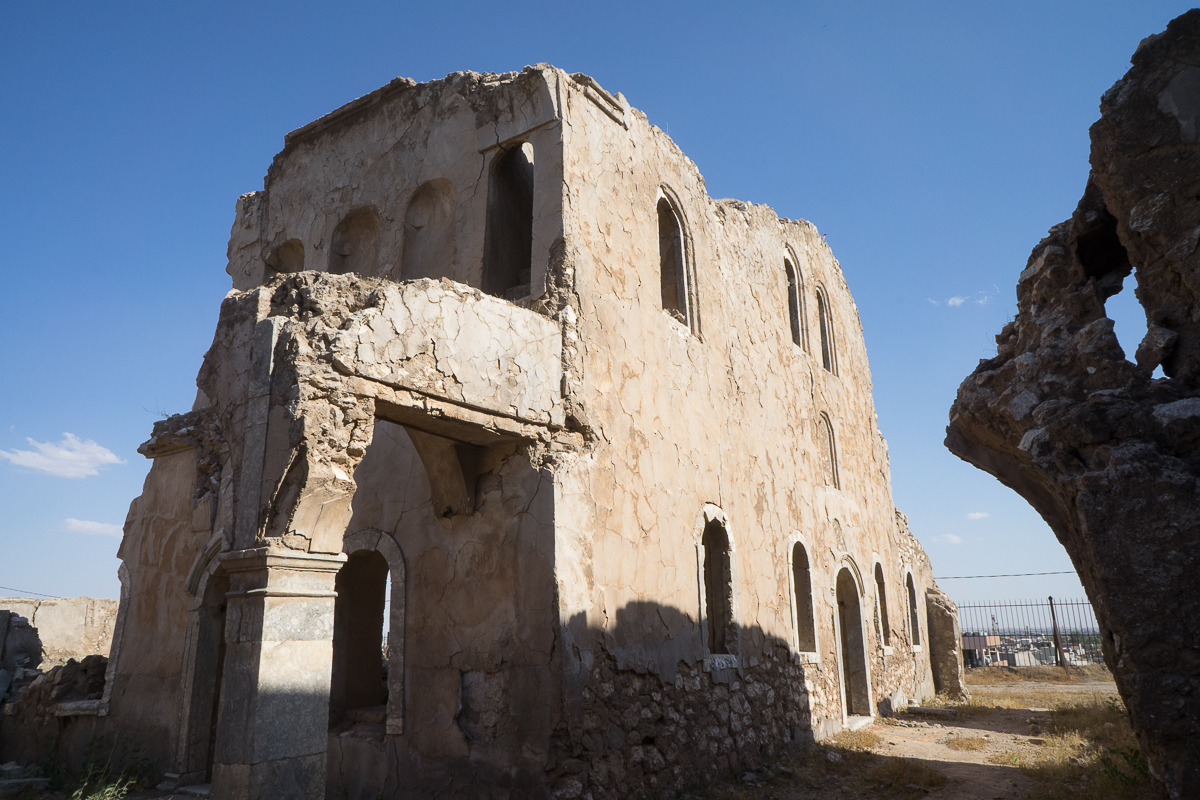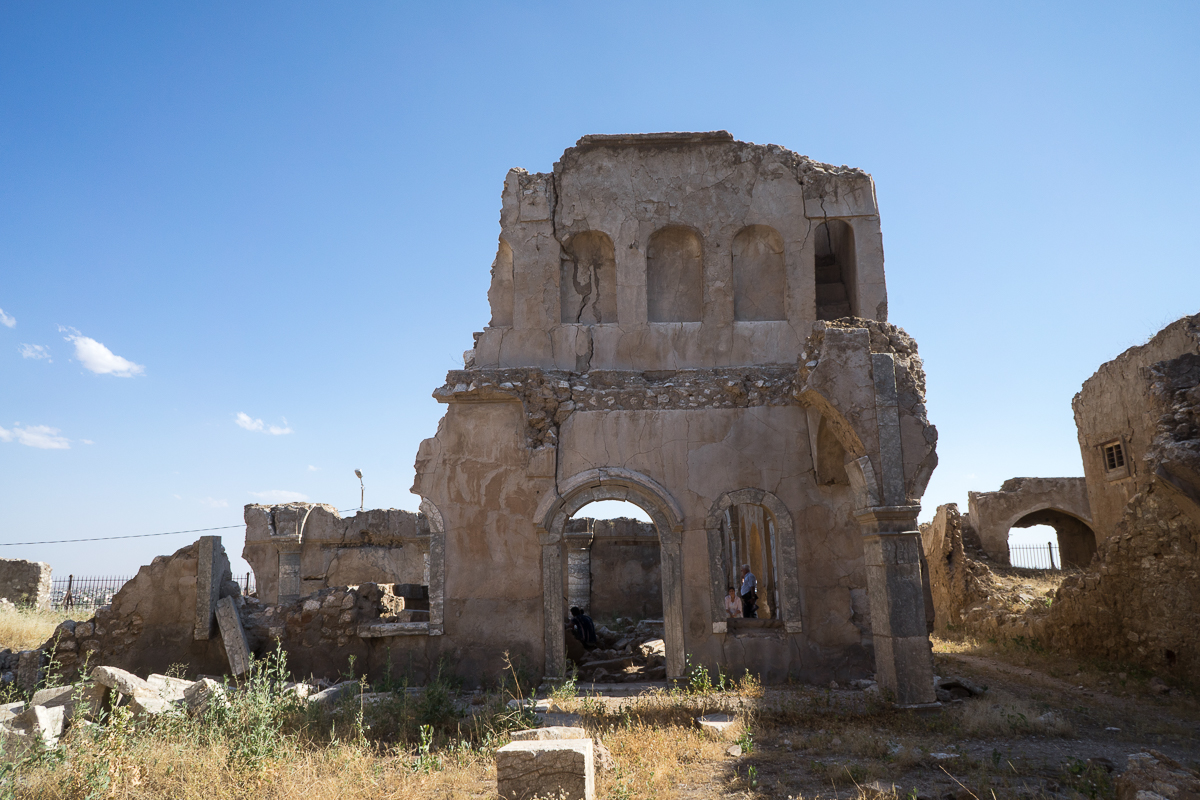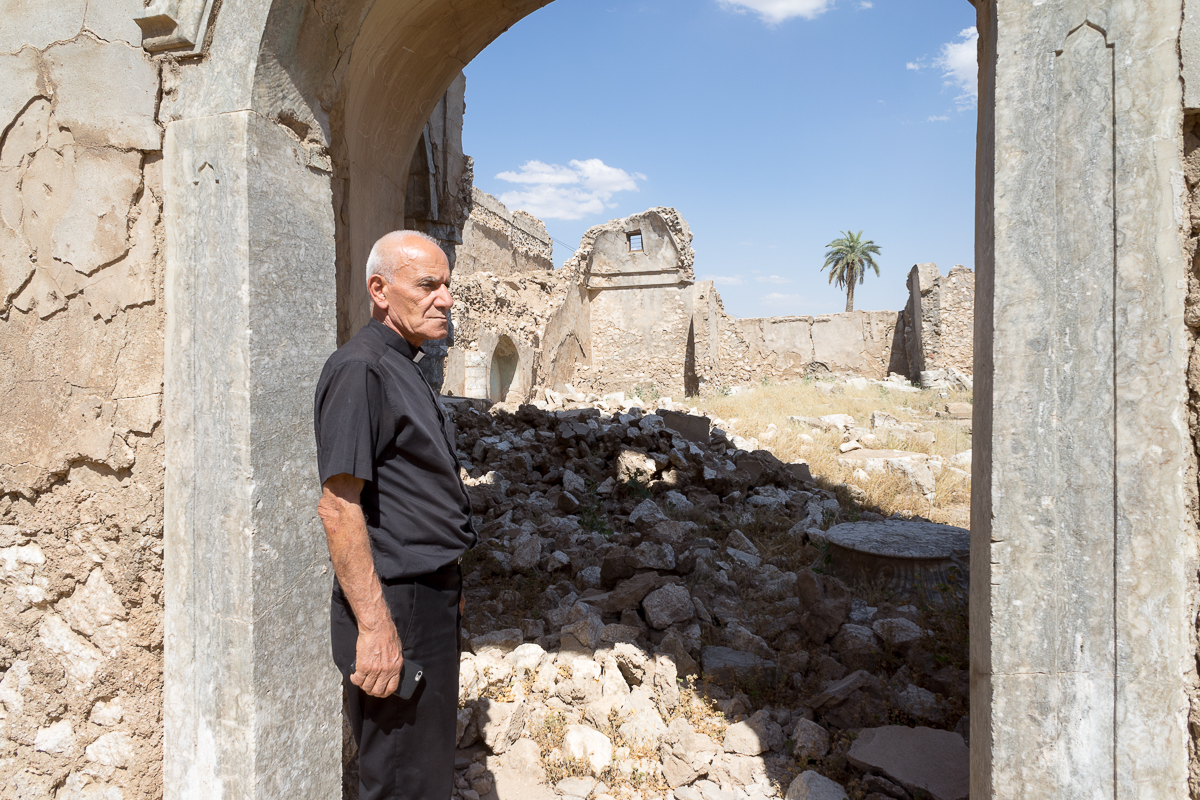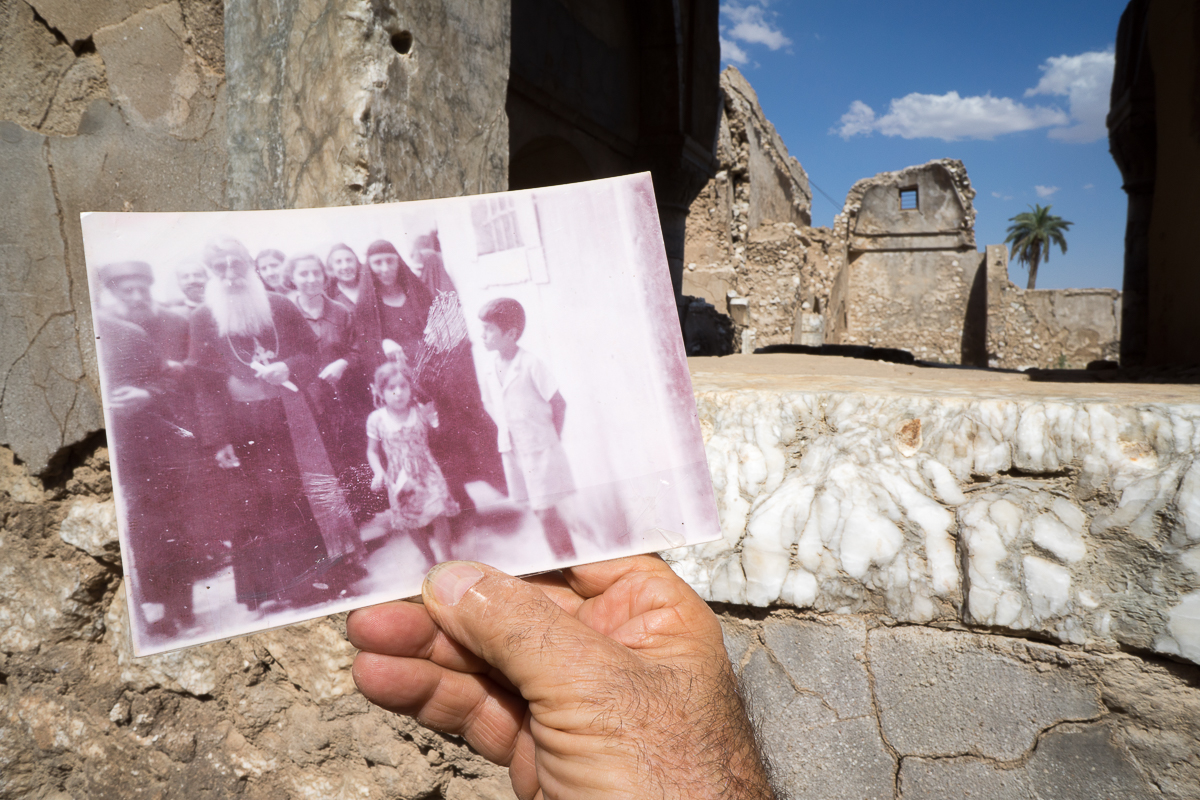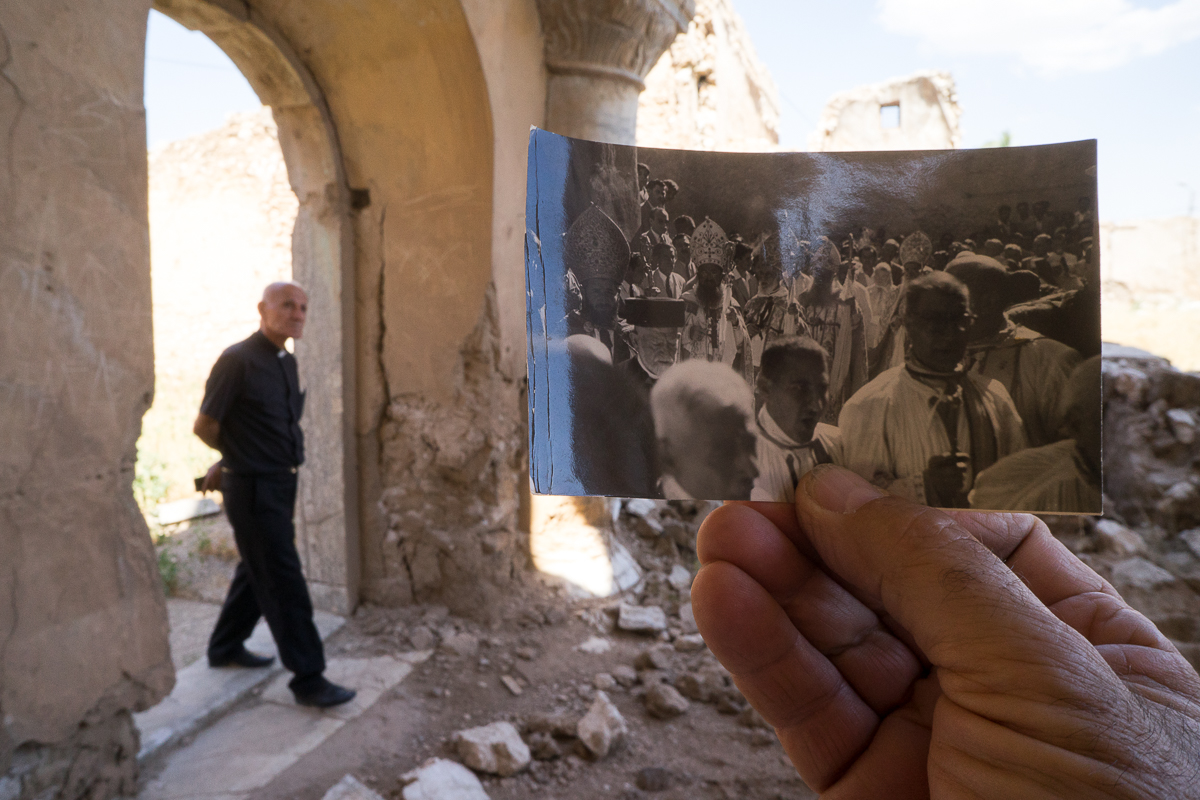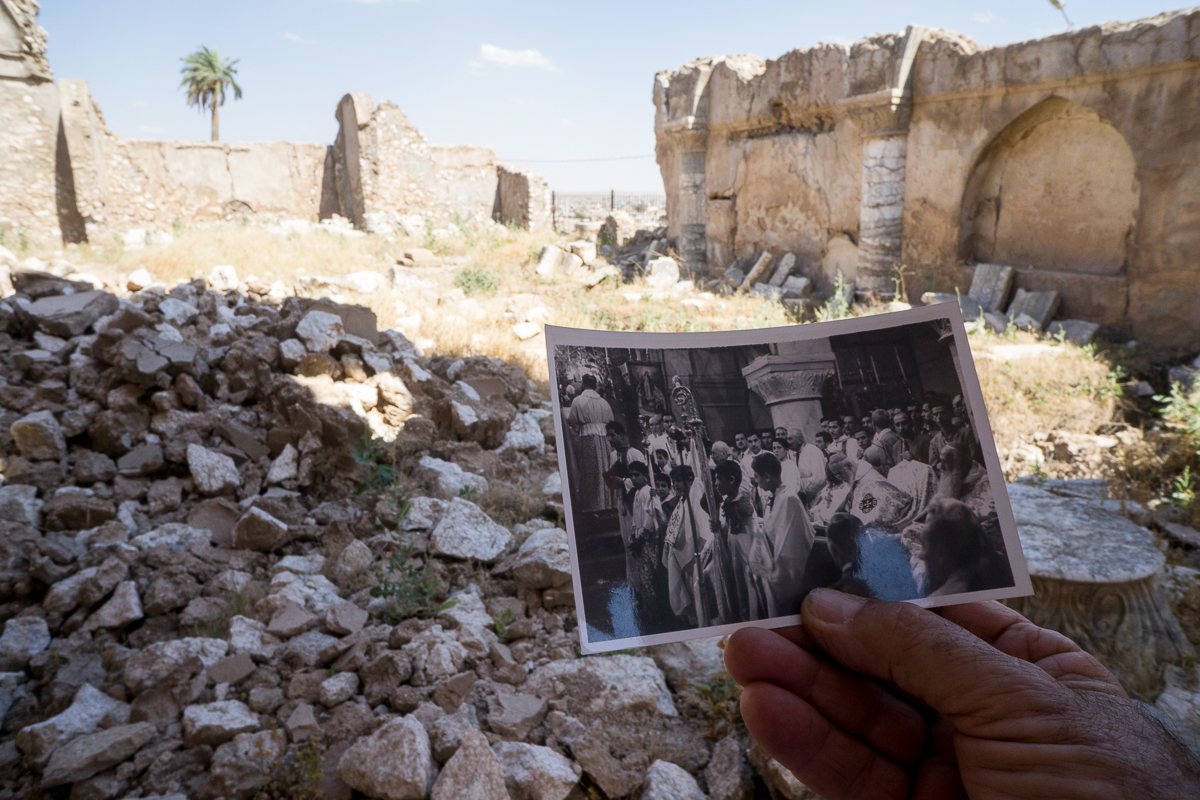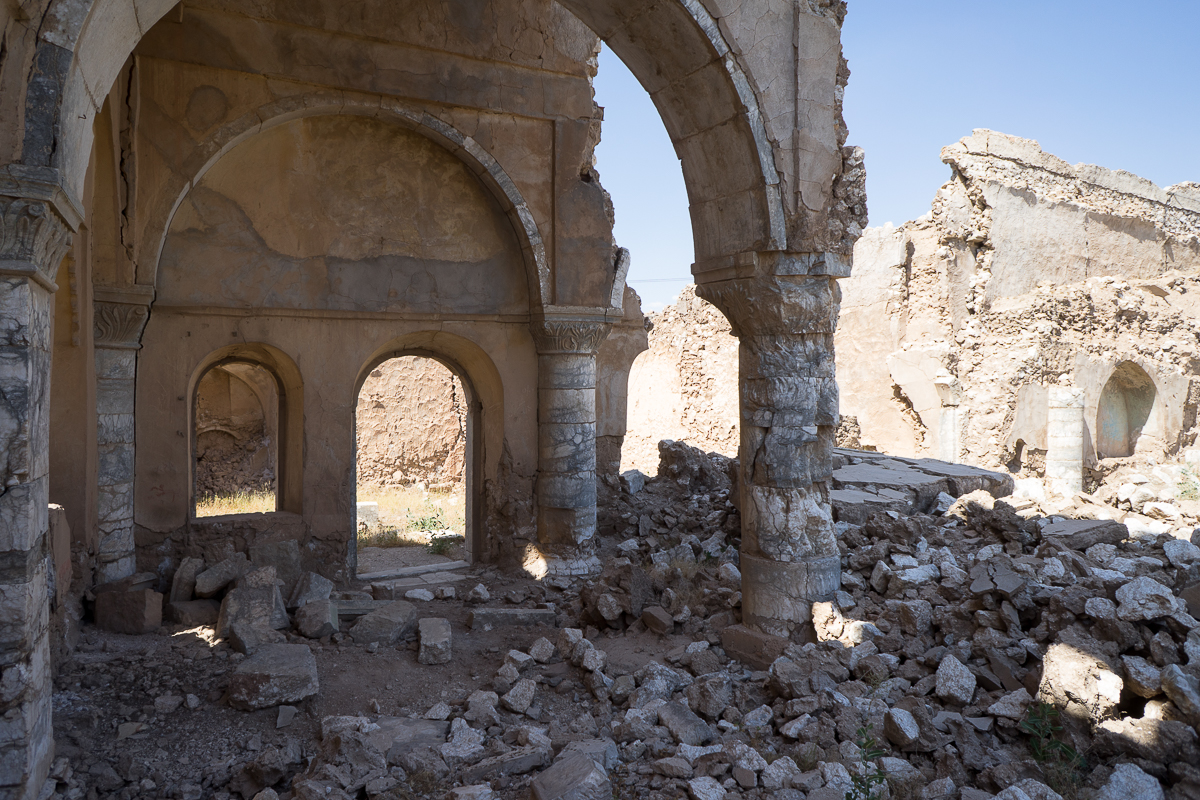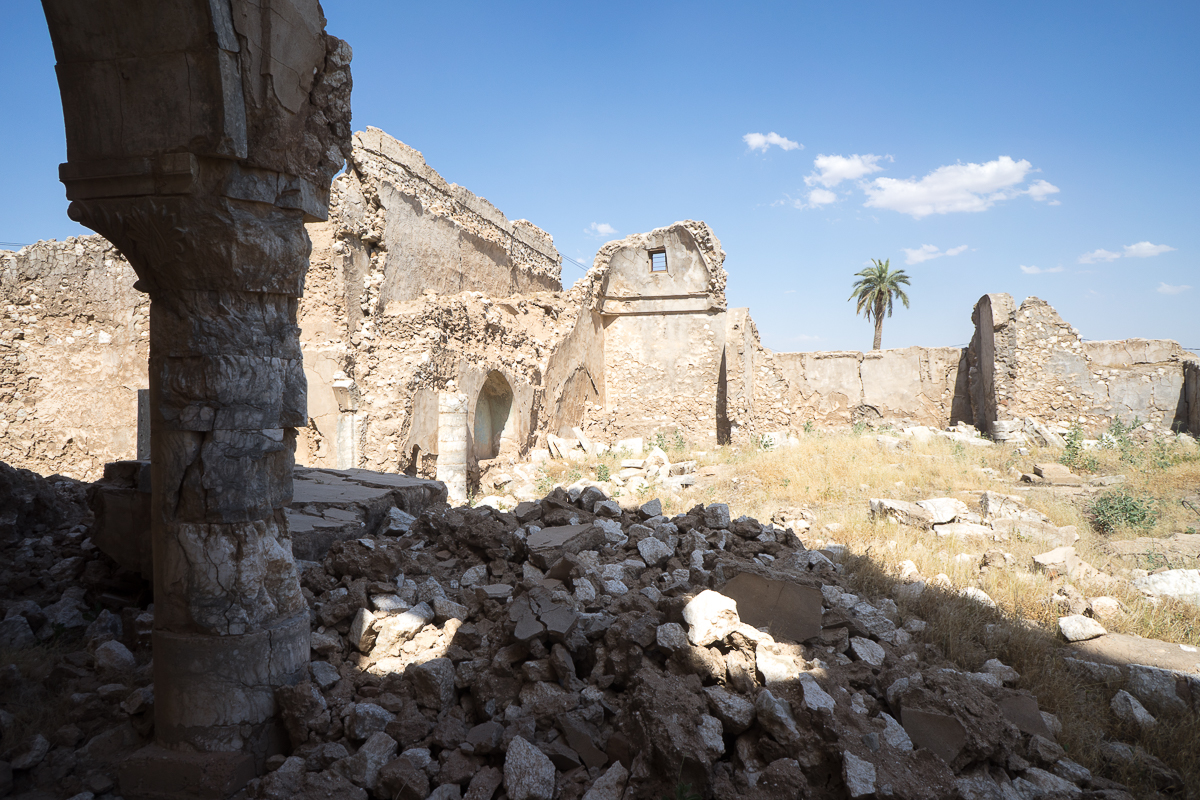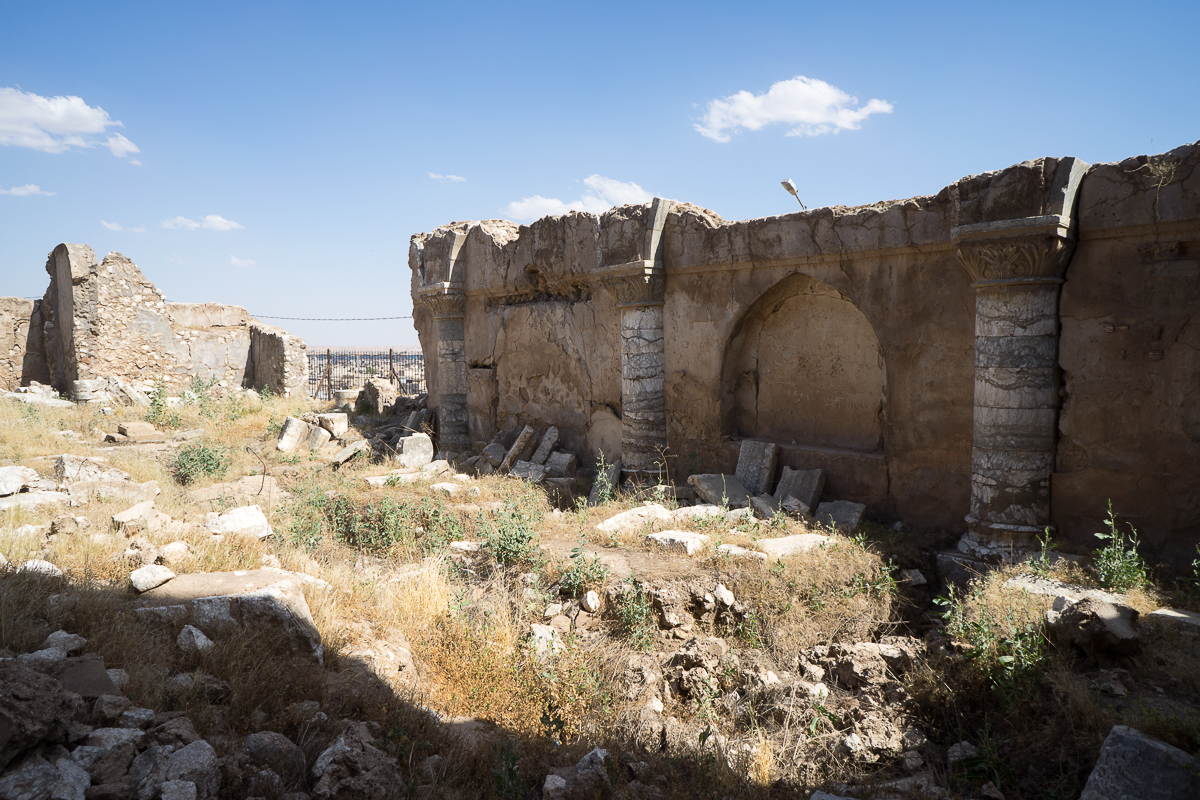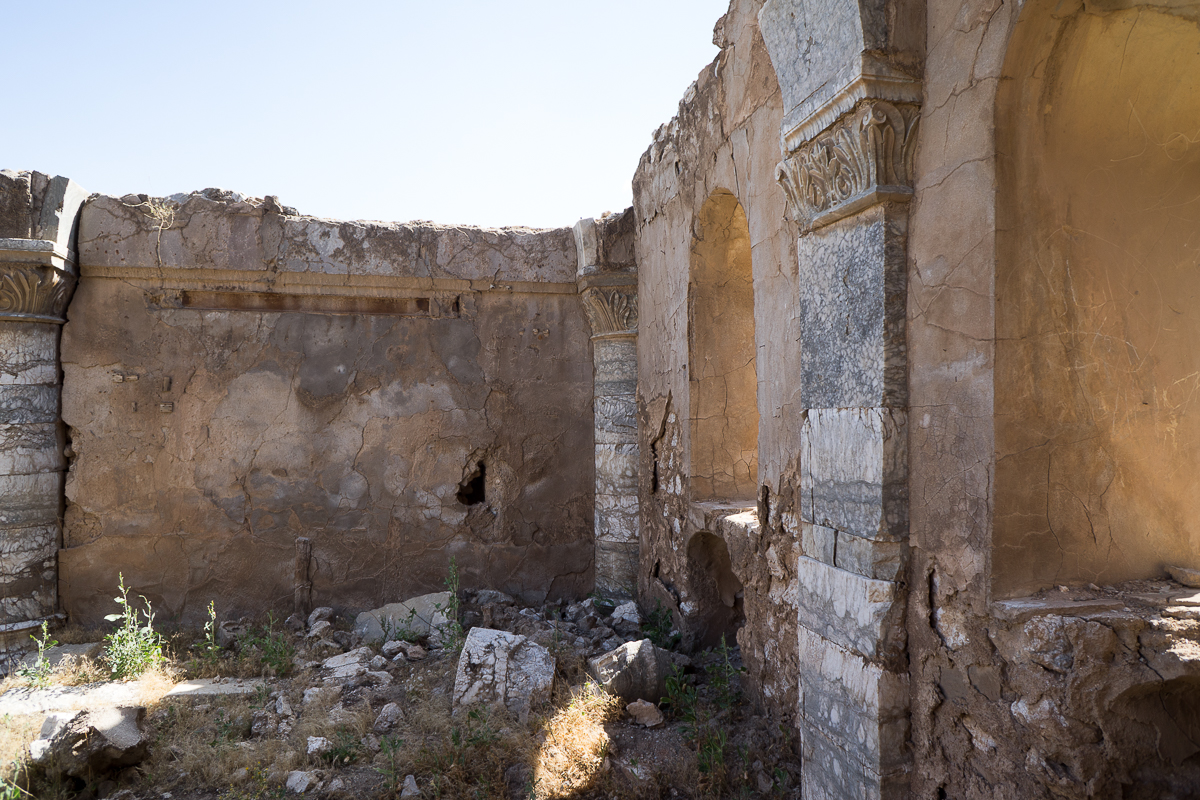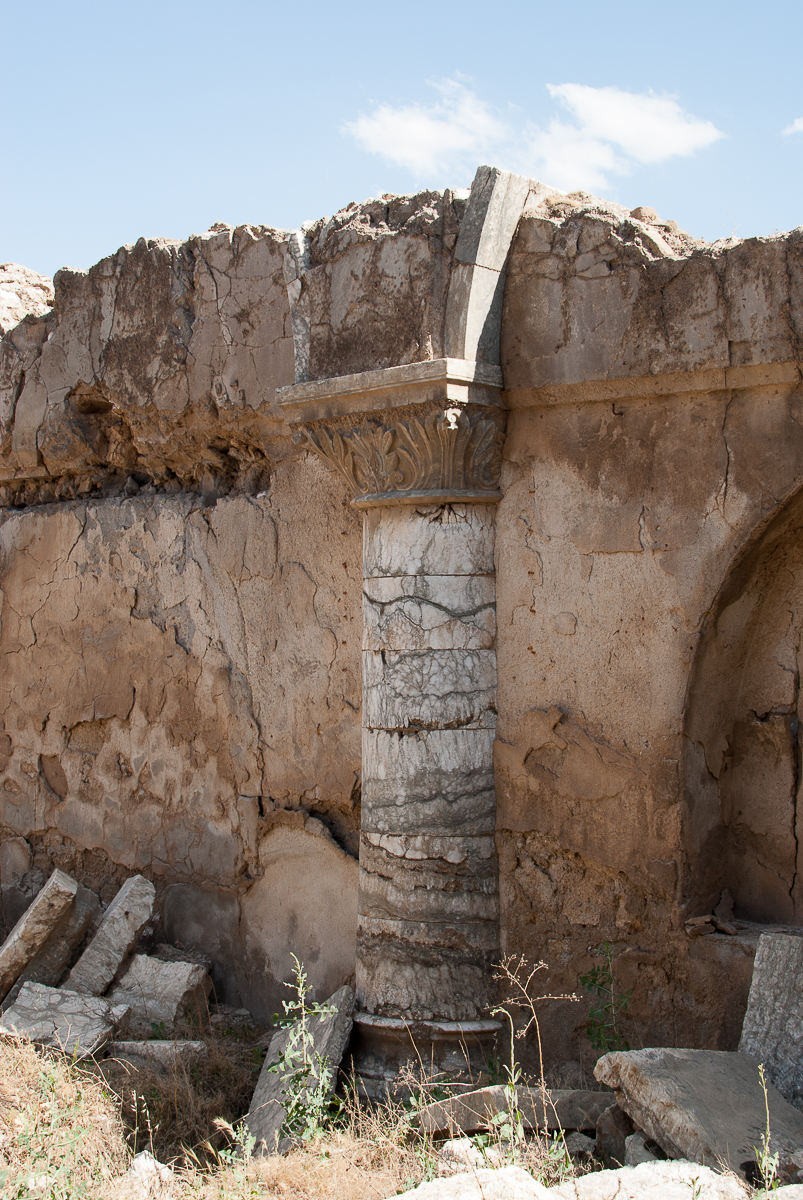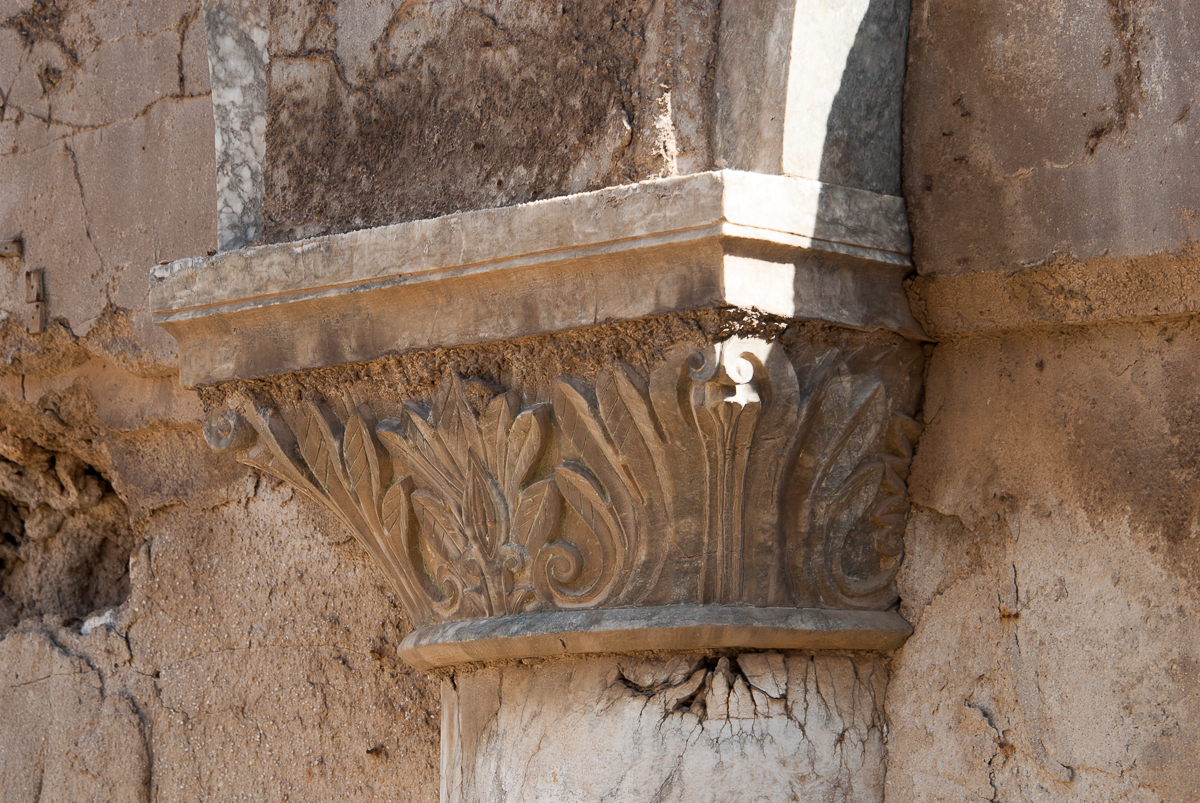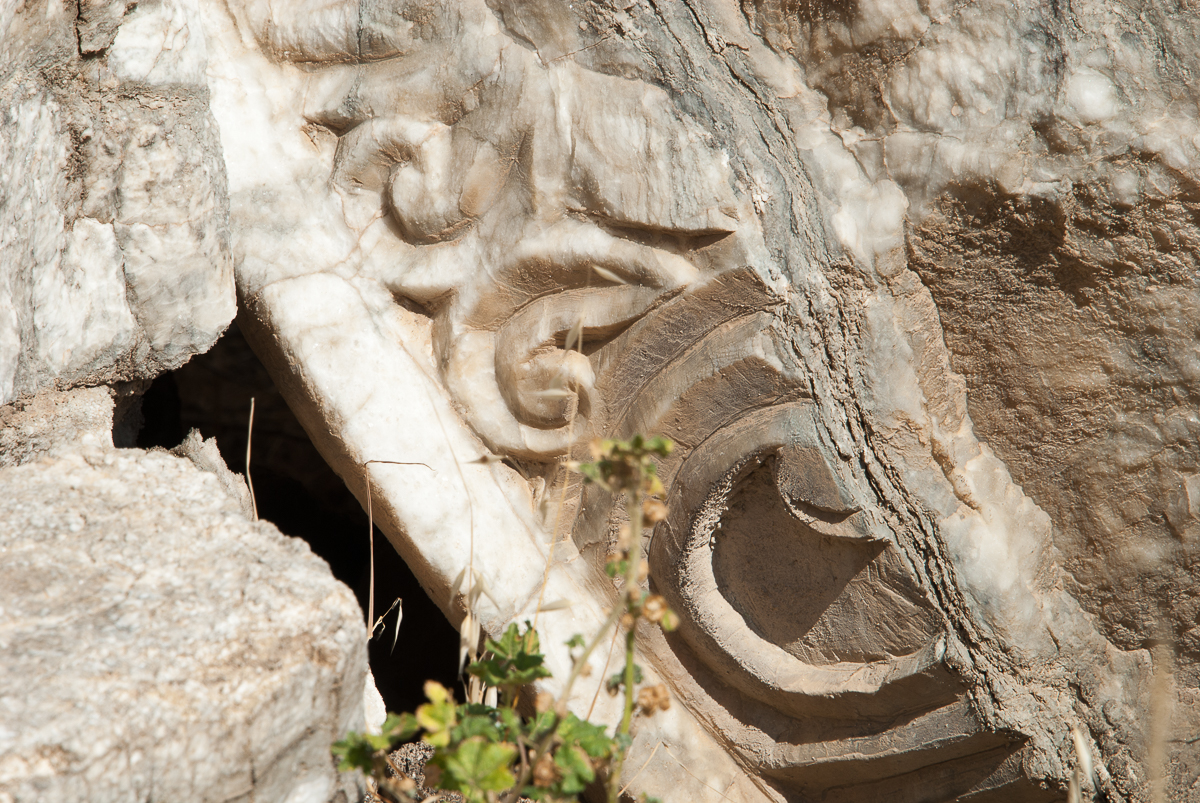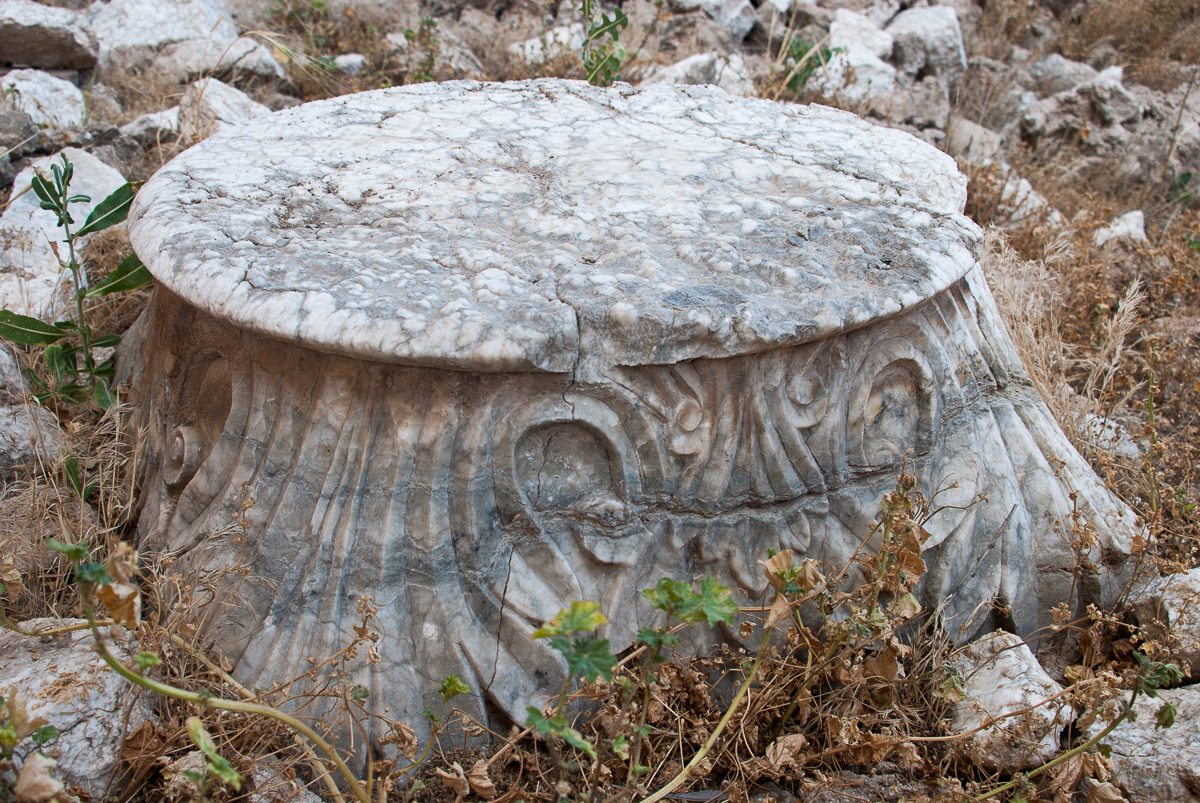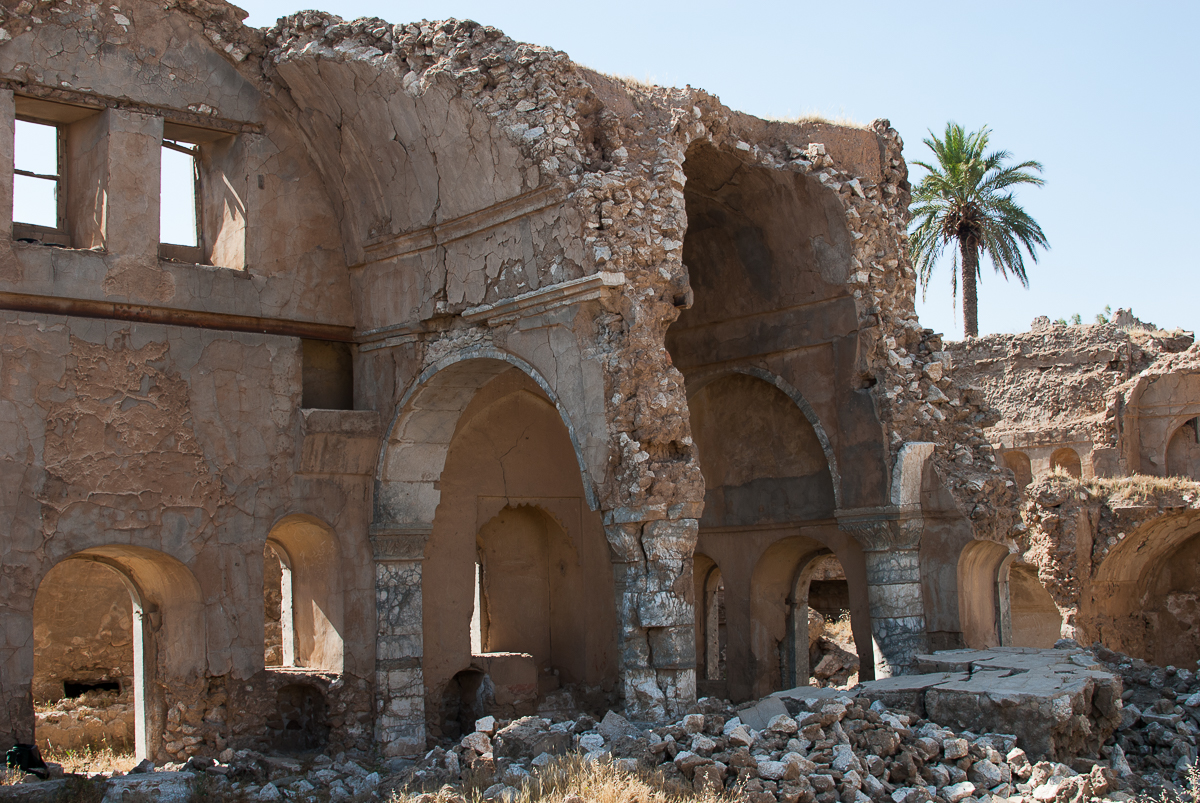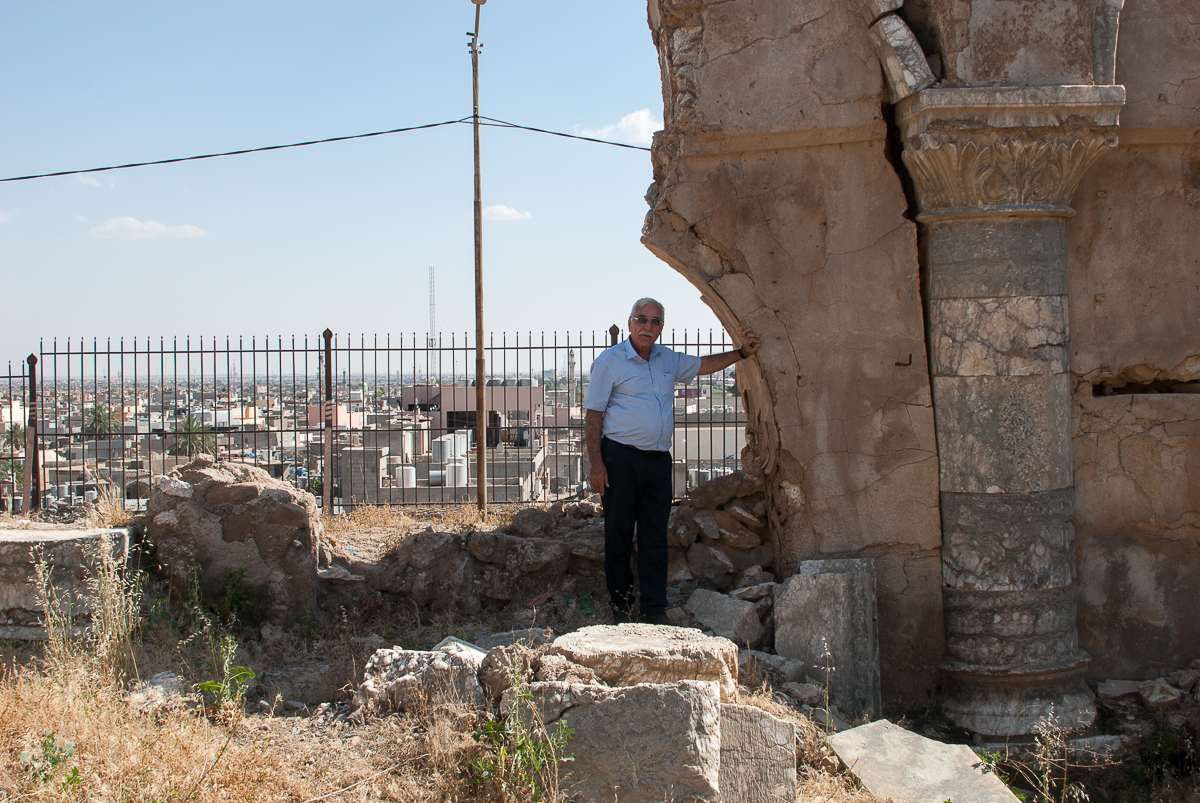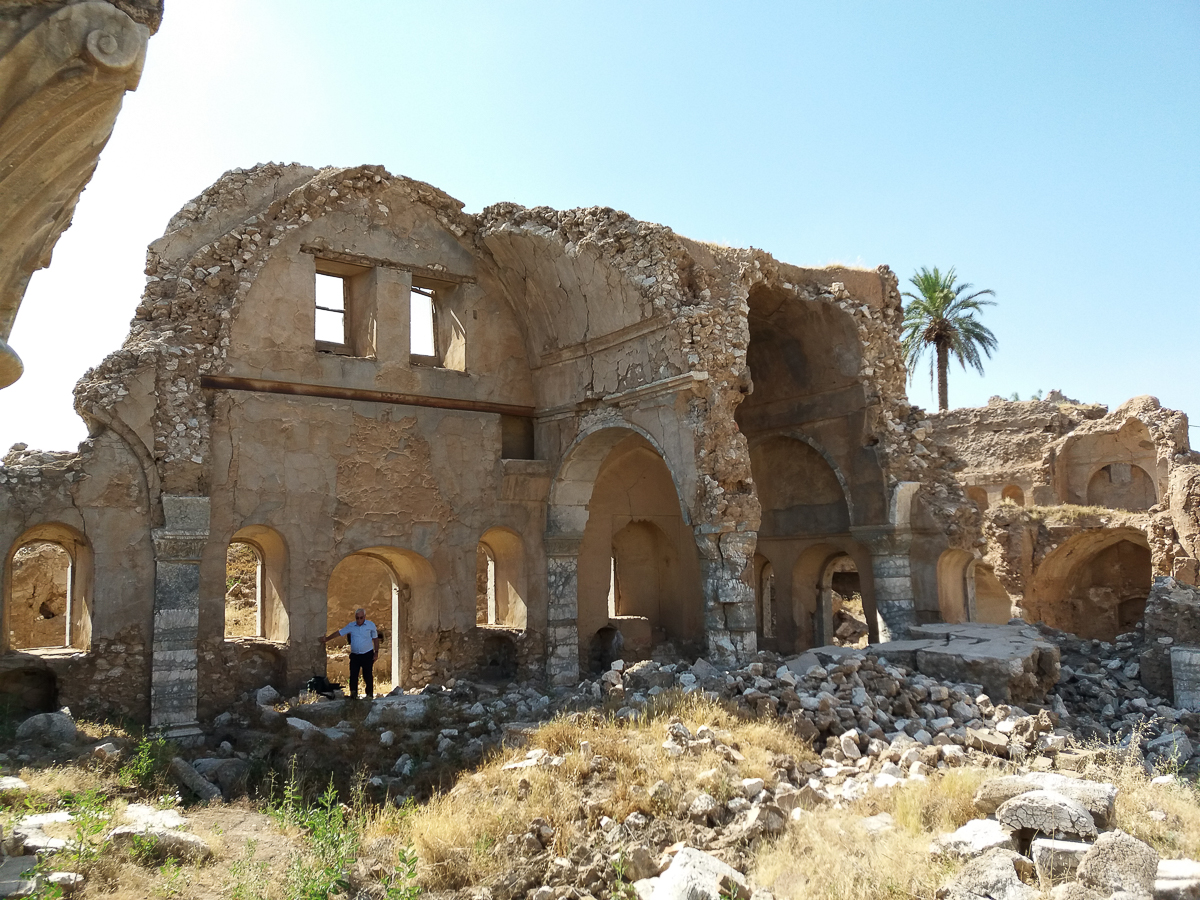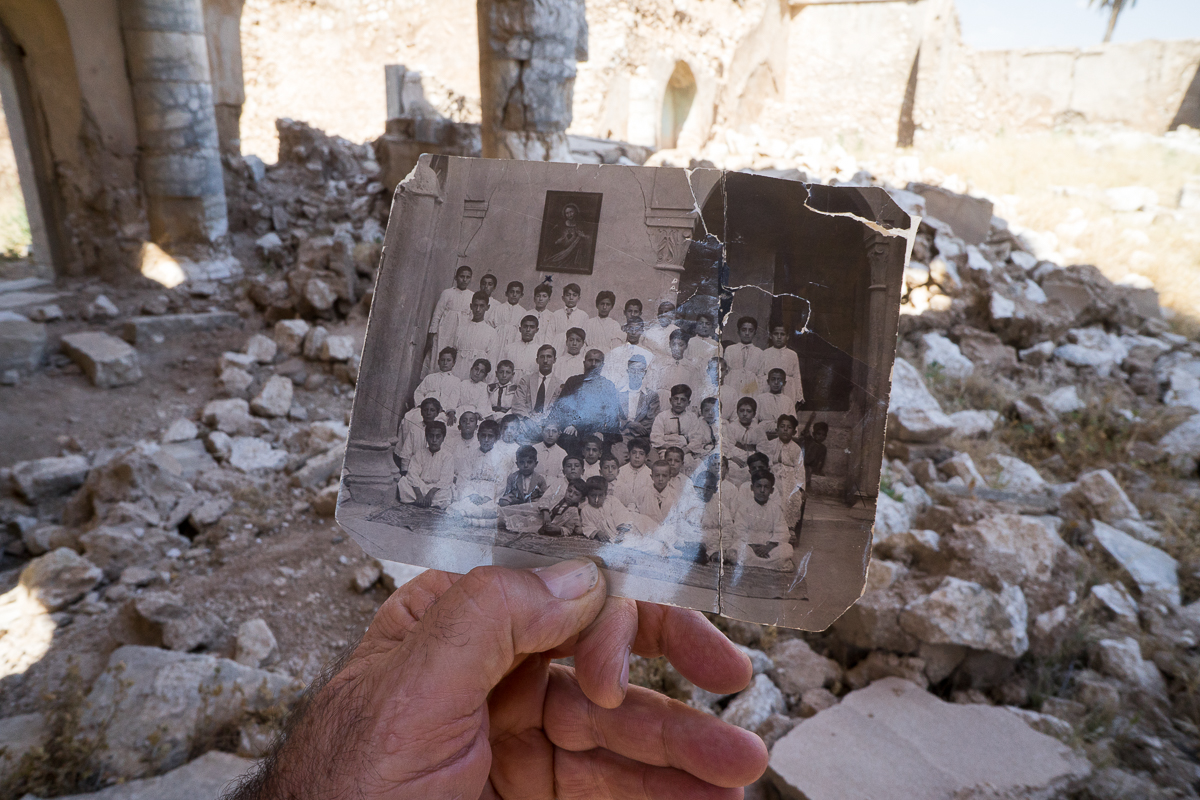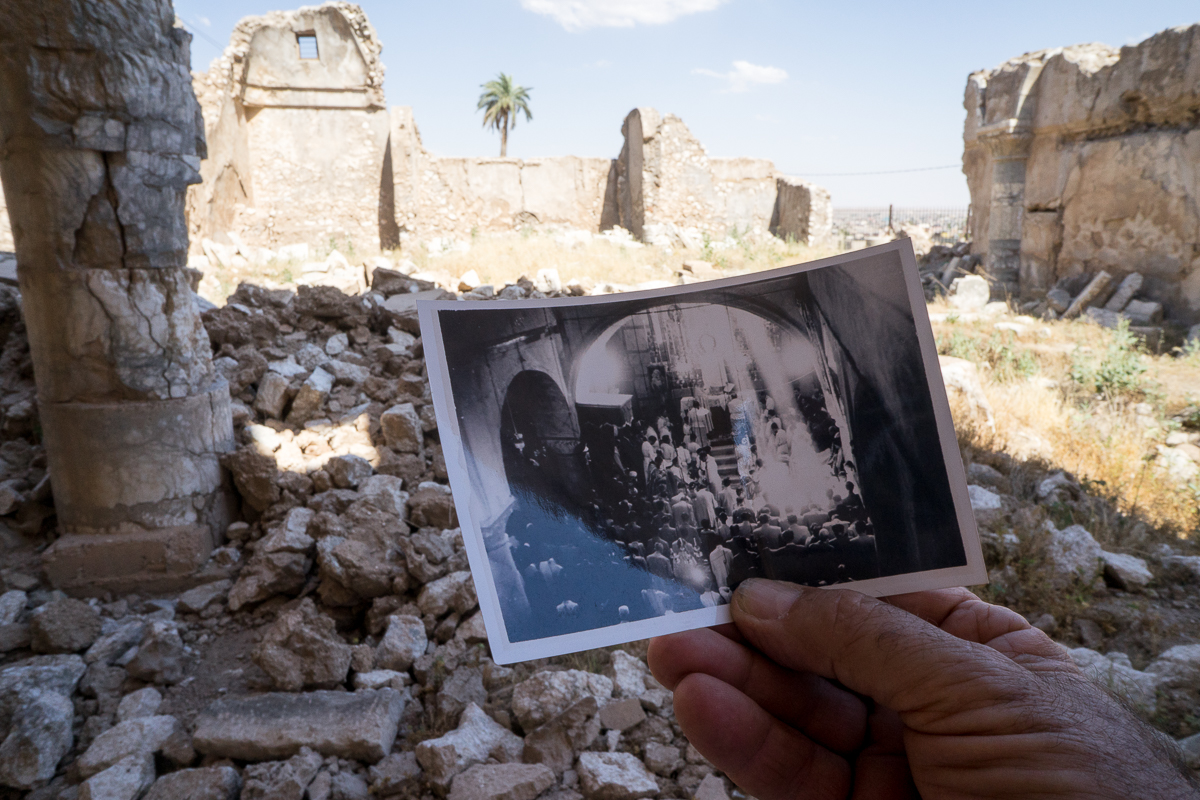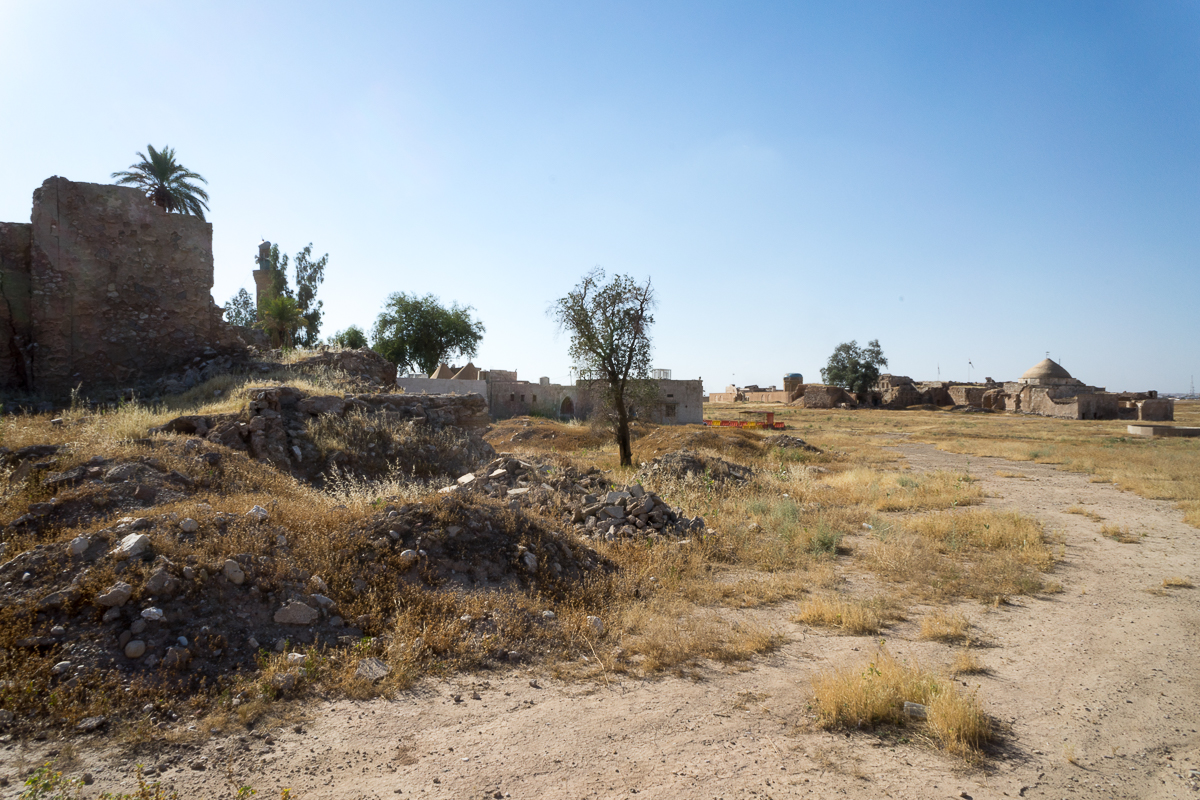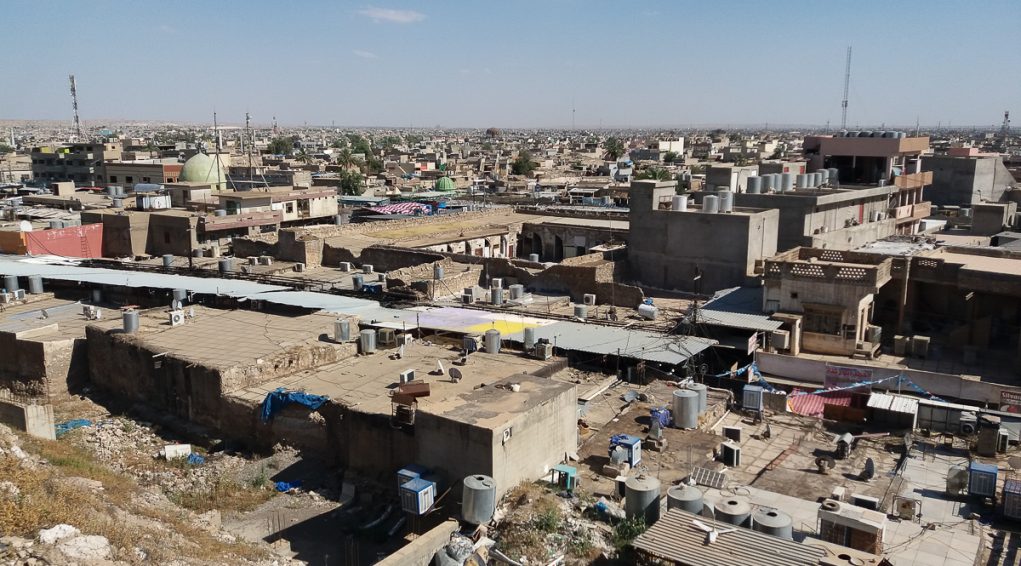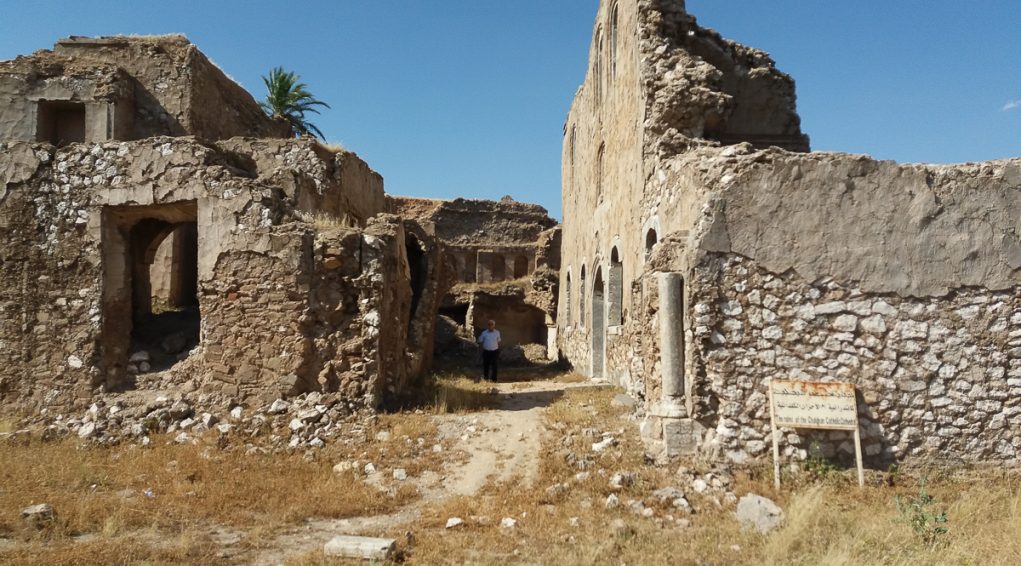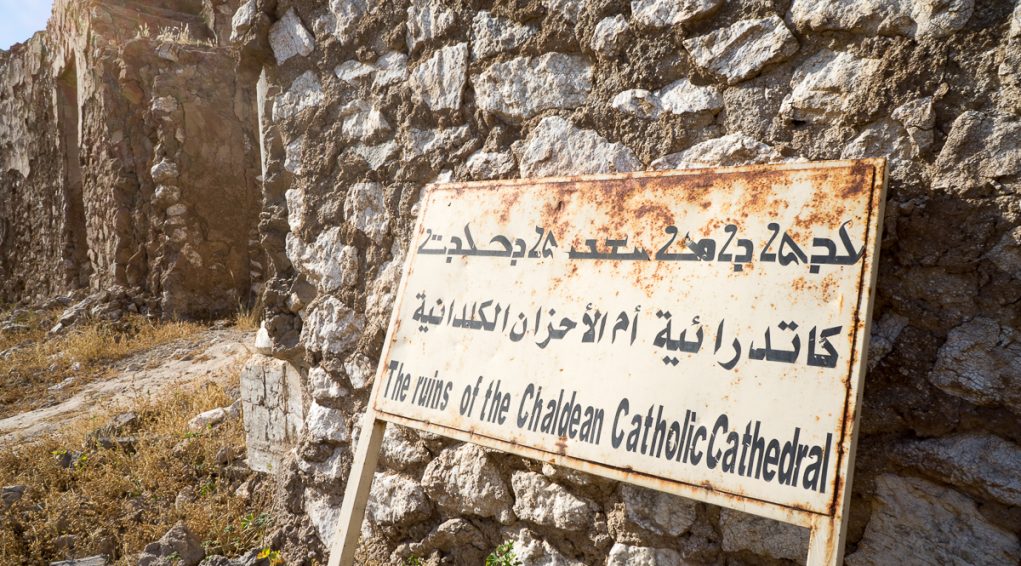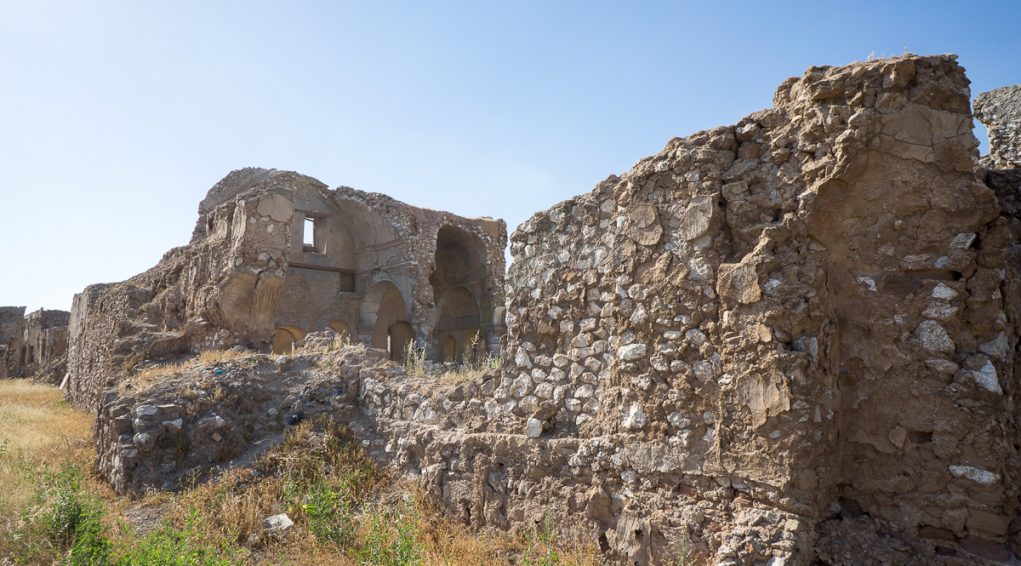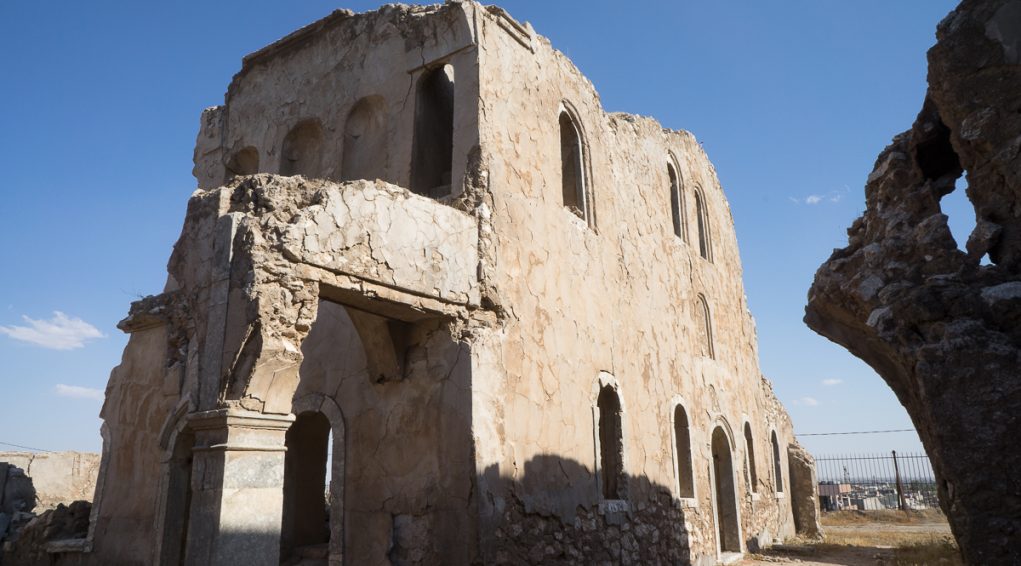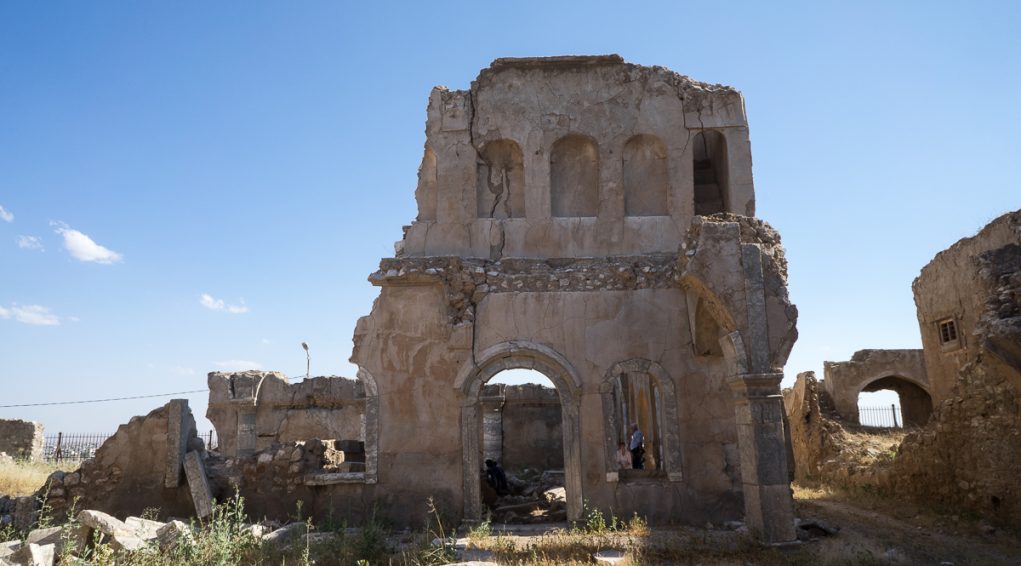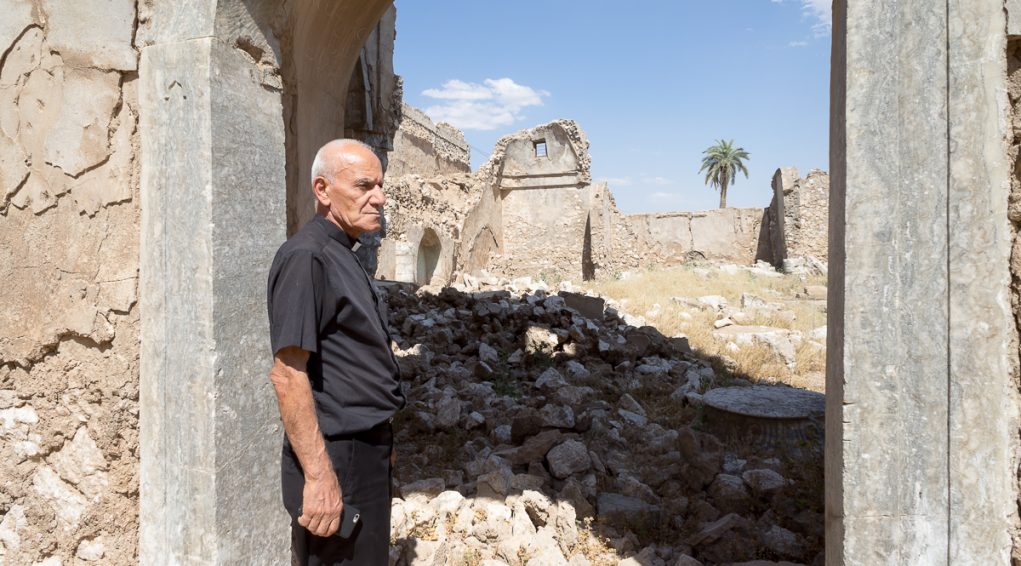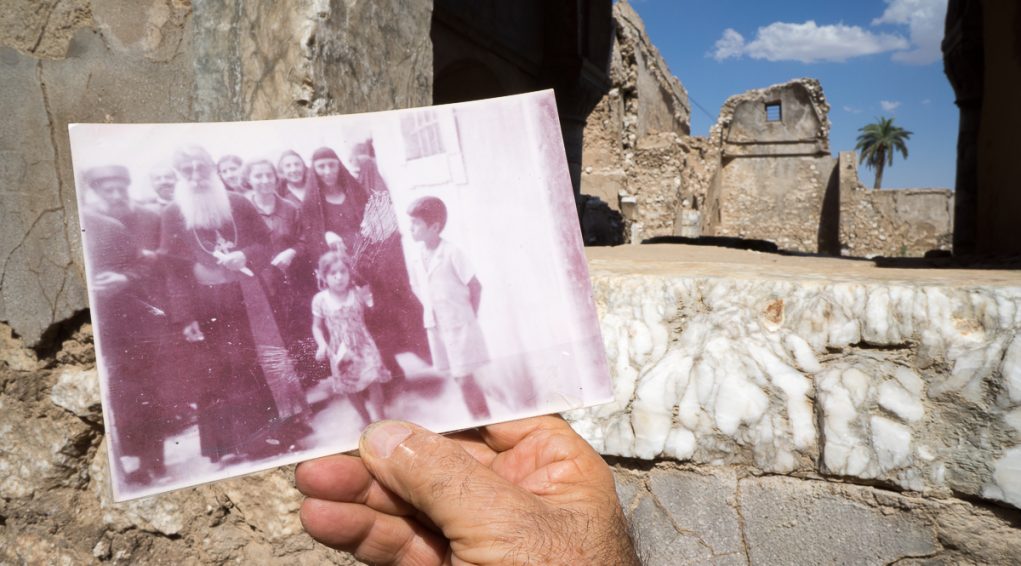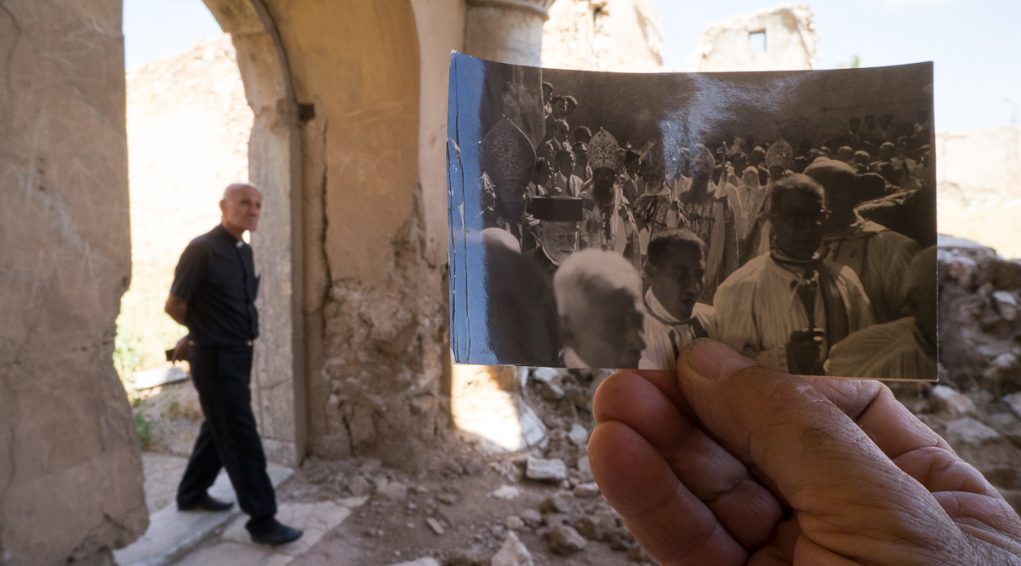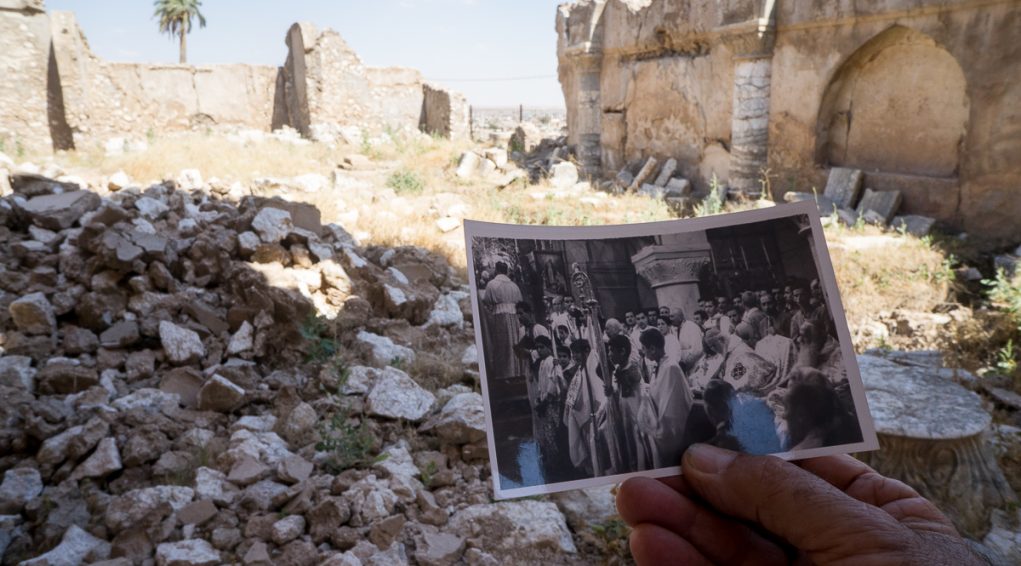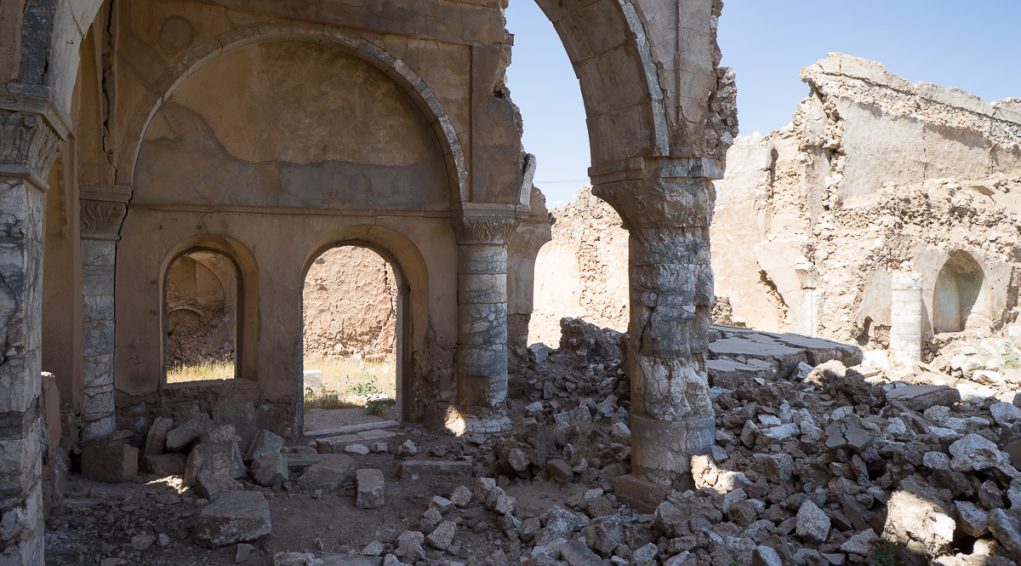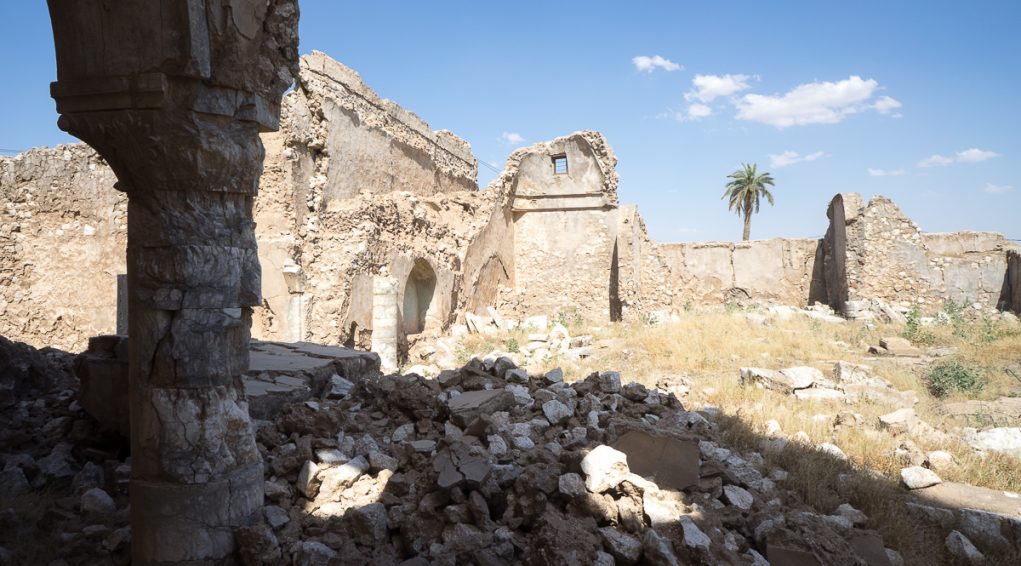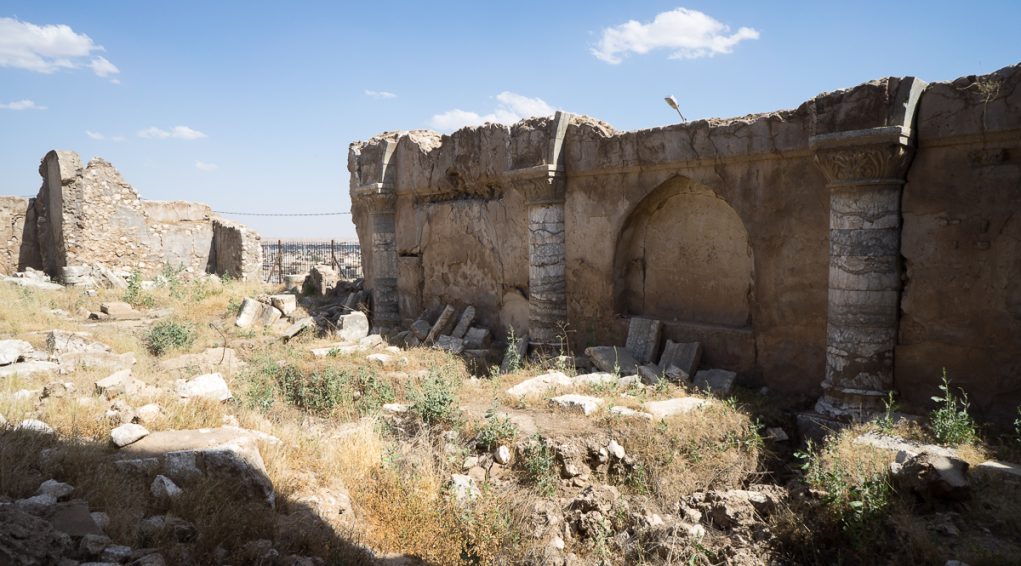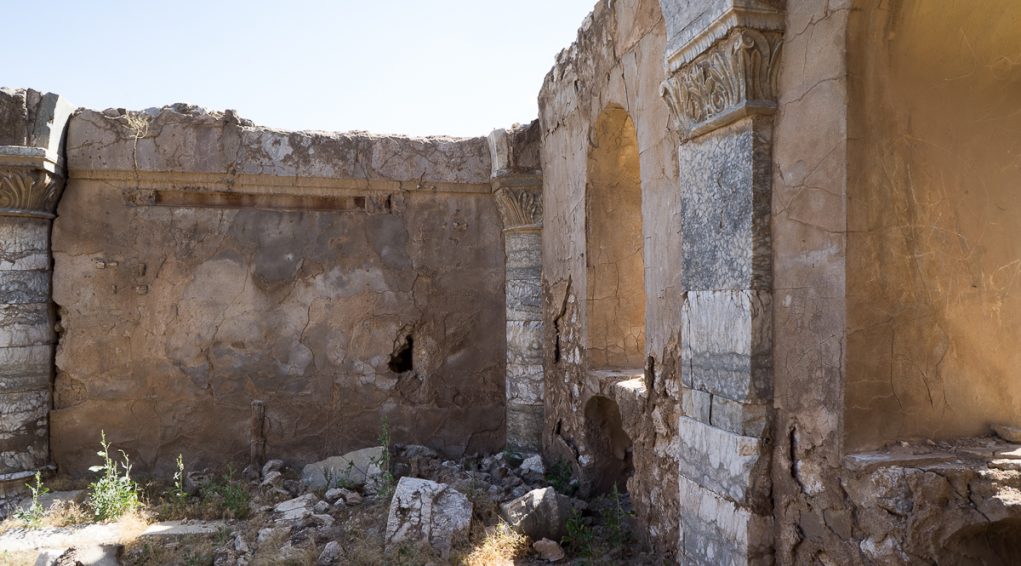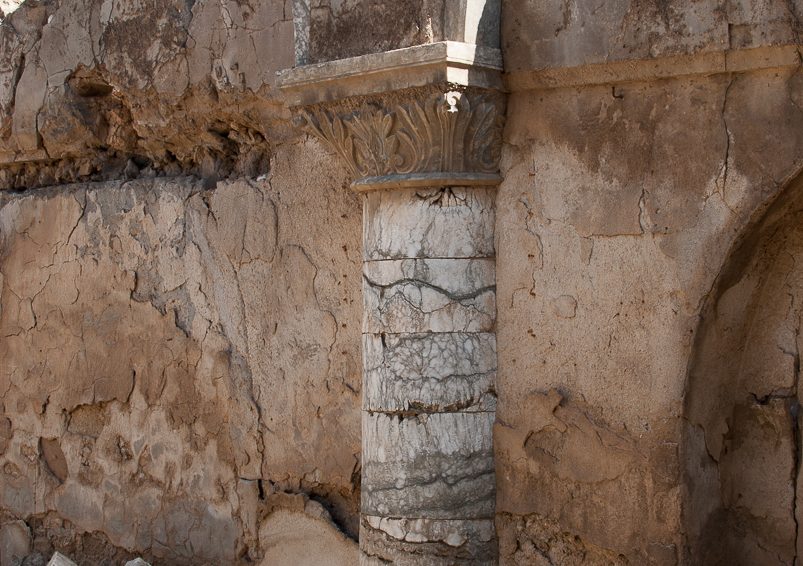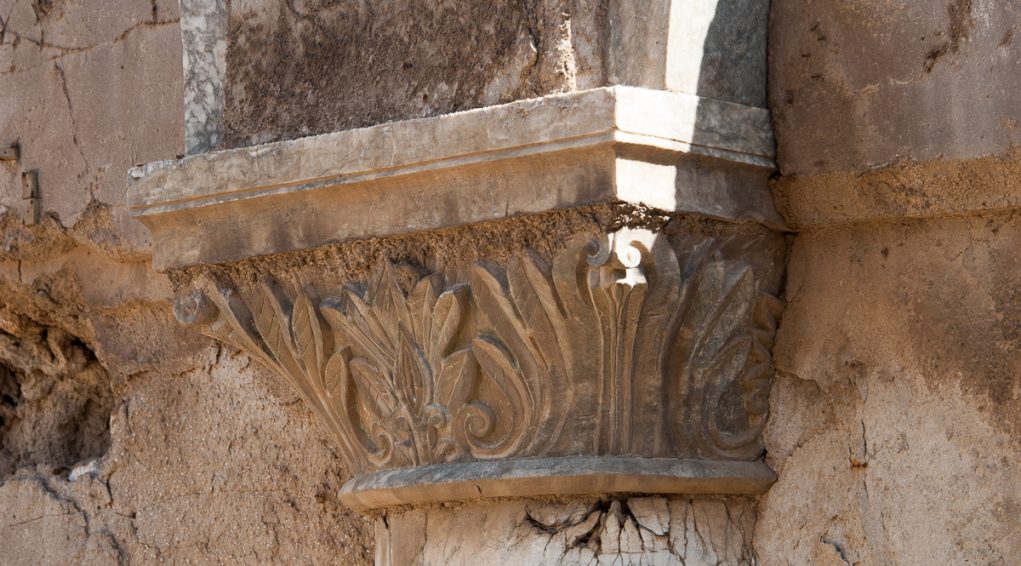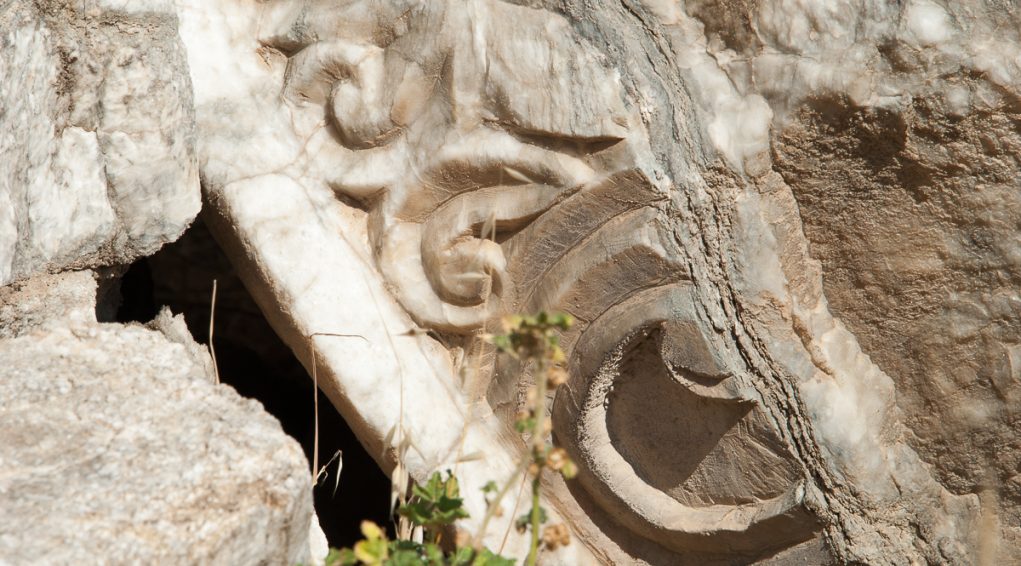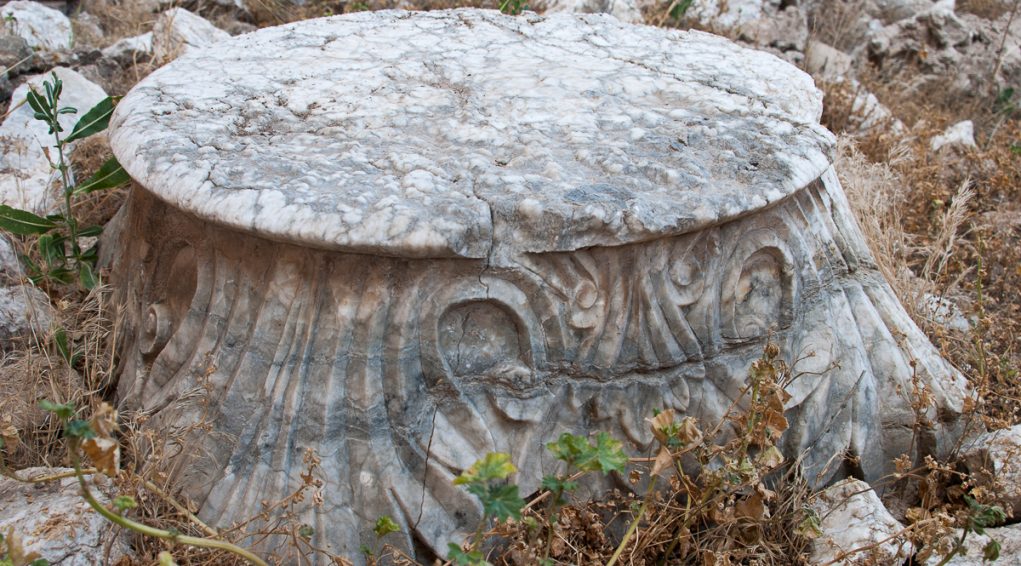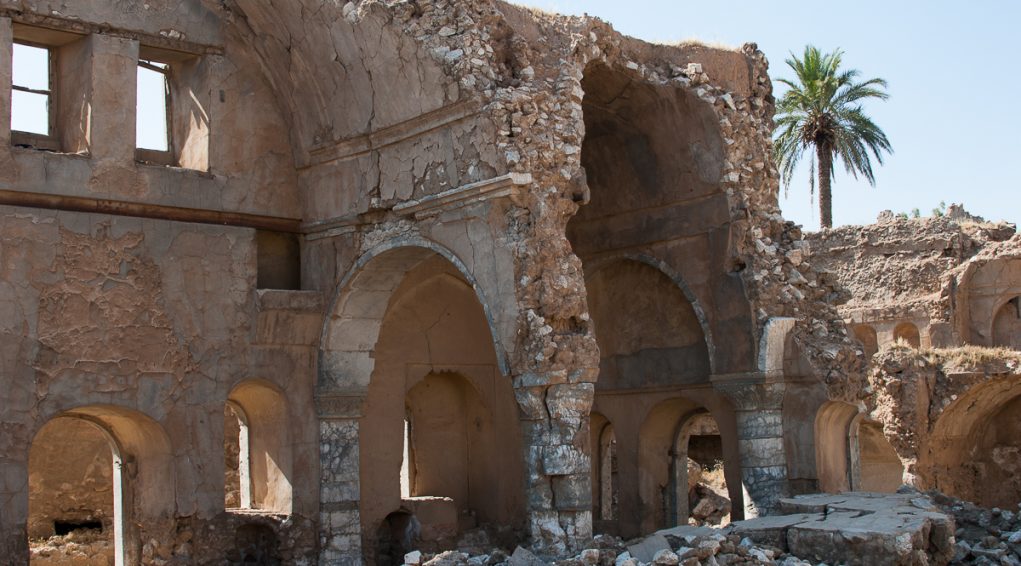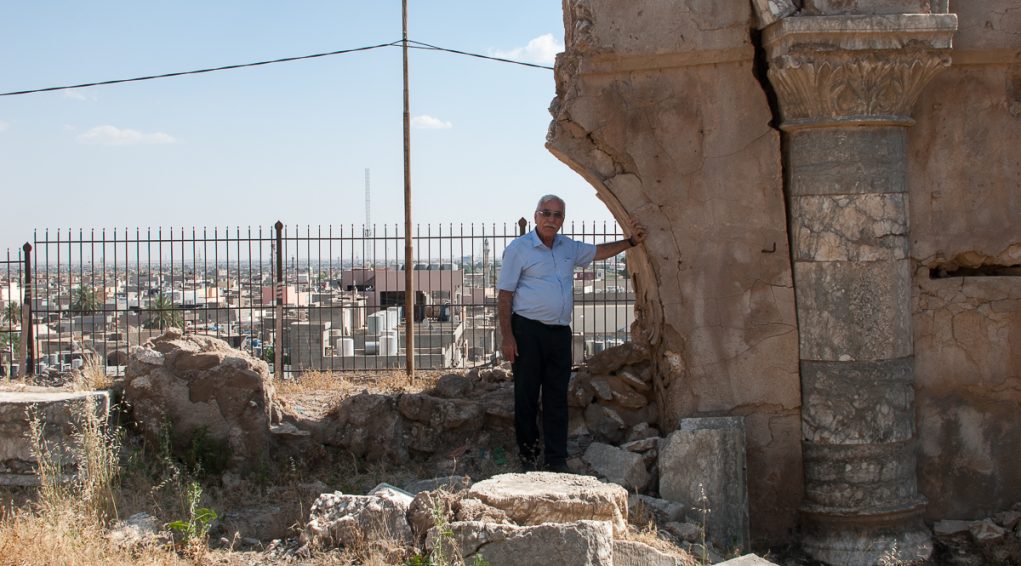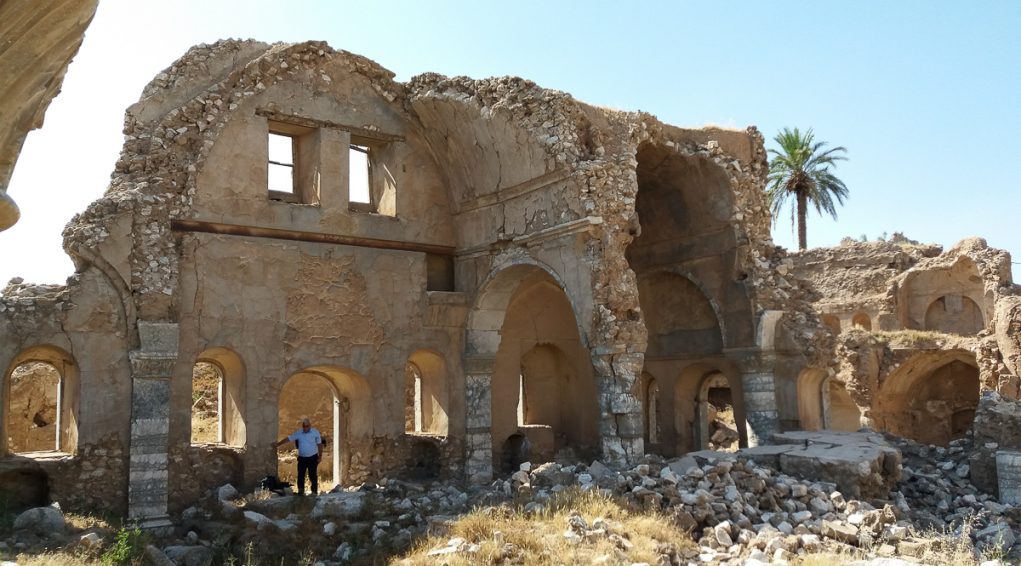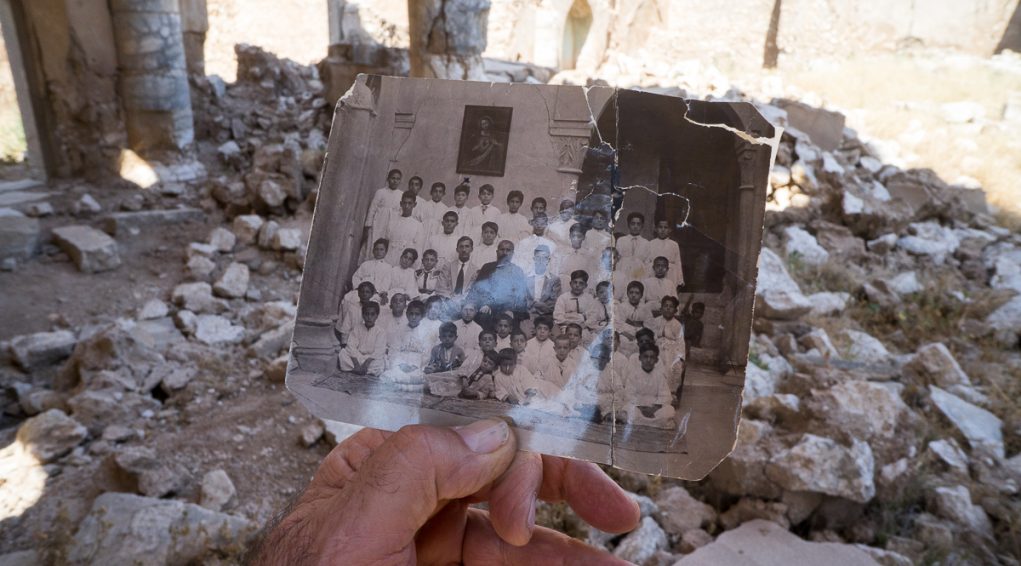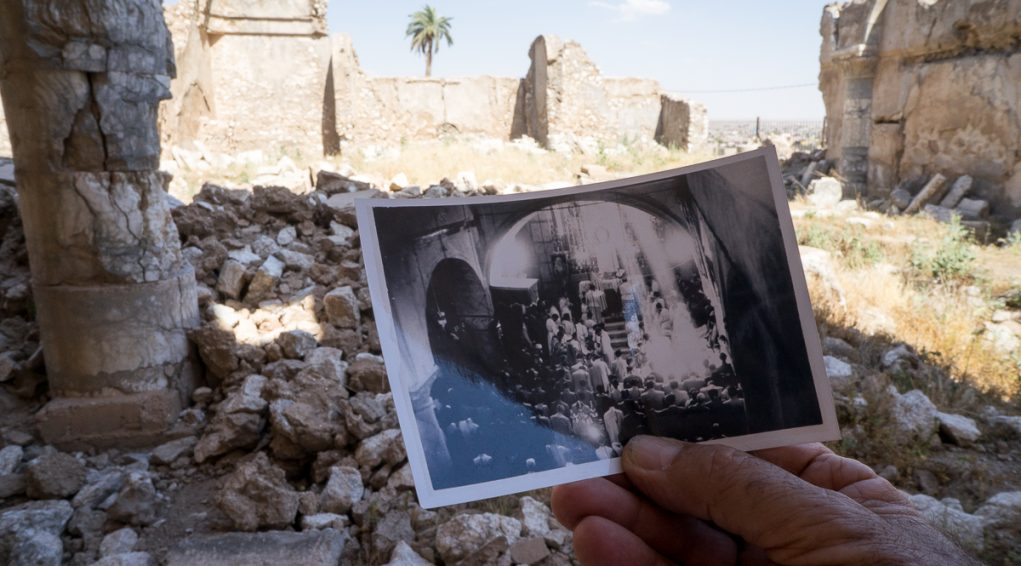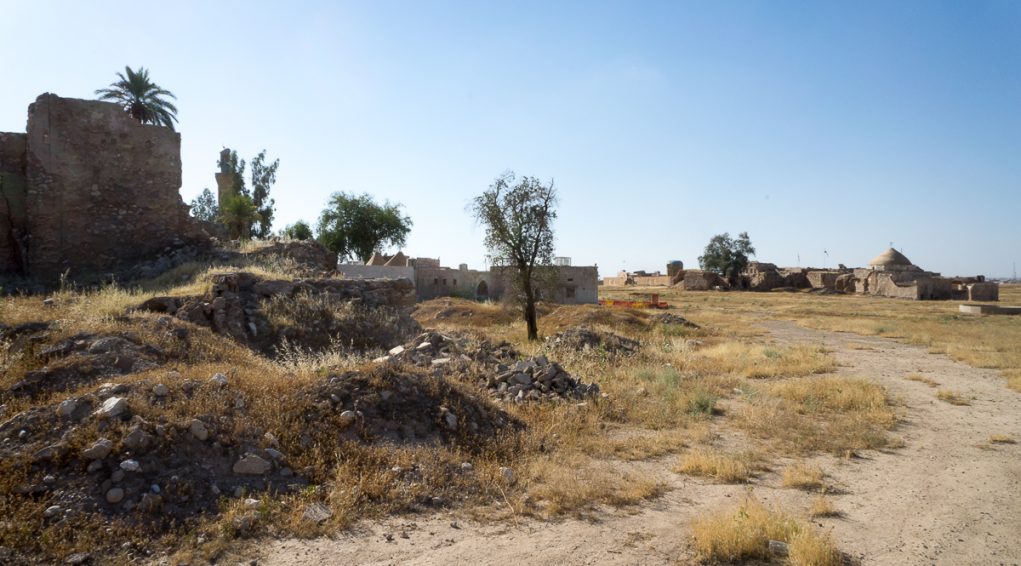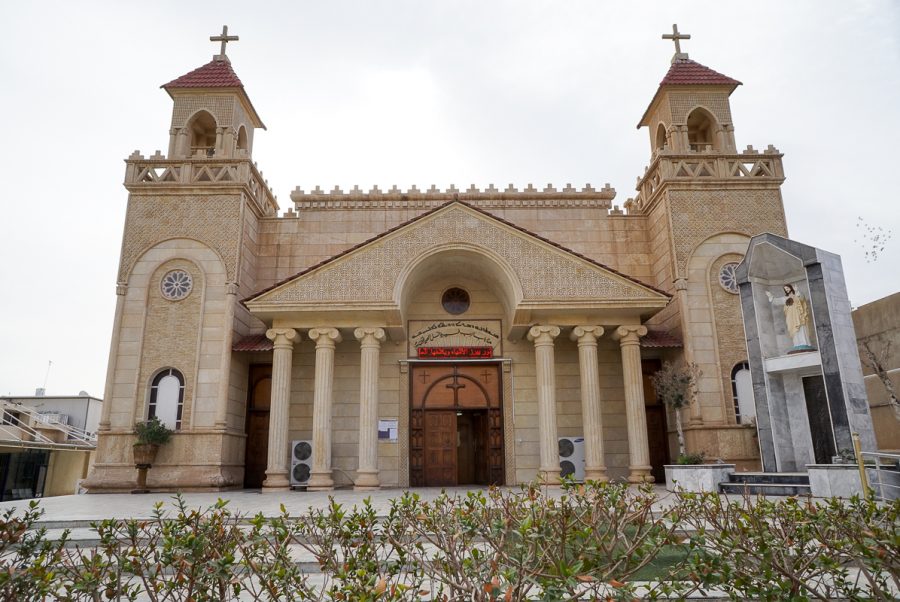The ancient cathedral Om Al Ahzane in the citadel of Kirkuk (and other Christian buildings in the citadel)
The ancient cathedral Om al Ahzane in Kirkuk is located at 35°28’14.44″N 44°23’45.86″E and 364 metres altitude on the tell (hill) on which the citadel stands.
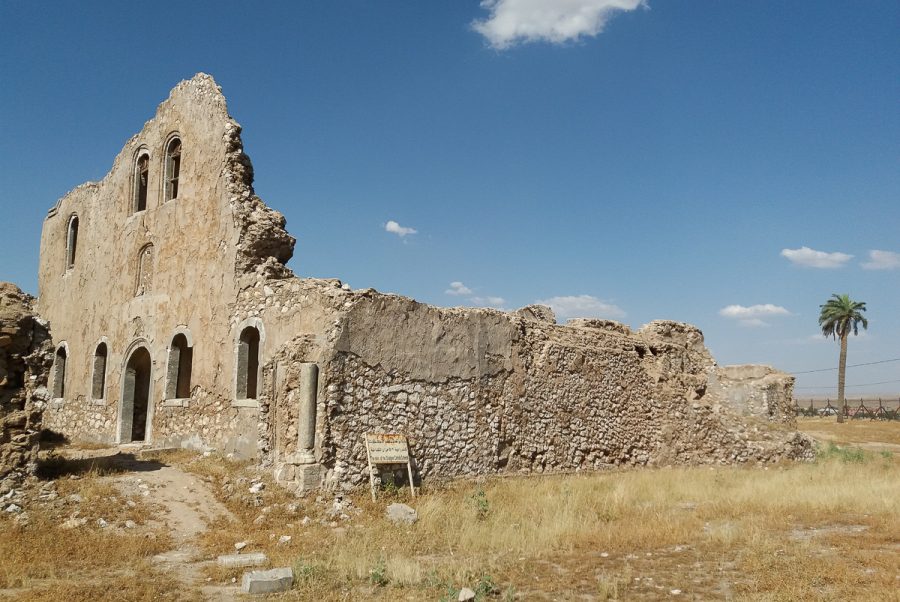
The ancient cathedral Om al Ahzane in Kirkuk was built during the second half of the 19th century and consecrated in 1862 under the name of Mother of Sorrows (or Our Lady of Seven Sorrows).
It made it possible to relocate local Christian activity to this vast tell, whereas the majority of Chaldeans were settled in Koria, two kilometres from the citadel.
This large cathedral, which is now in ruins, collapsed for a number of reasons. As well as being affected by humidity and significant climatic variations, the load of a vault was too heavy for the overly fragile pillars and the stone walls were also held together with very precarious mortar. Finally, the incorrect use of cement and concrete to salvage the building in 1961 also aggravated the problem.
The site can still be visited today, even though it is still falling apart. There are no plans to restore or promote the building’s heritage.
Pic : The ancient cathedral Om al Ahzane in Kirkuk. June 2018 © Pascal Maguesyan / MESOPOTAMIA
Location
The ancient cathedral Om al Ahzane in Kirkuk is located at 35°28’14.44″N 44°23’45.86″E and 364 metres altitude on the tell (hill) on which the citadel stands.
Kirkuk, city and provincial capital, located to the east of the Little Zab. The Khasa river, a seasonal tributary of the Tigris, passes through the east side of the city. Situated to the north-east of Iraq, the region where the modern-day Kirkuk is located was known in ancient history as Bét Garmaï, formerly inhabited by the Garameans, possibly originating from “a Persian tribe which came to the region prior to Islam[1]”, but also possibly Ninevites and Chaldeans who spoke “Aramean certainly.”[2]
_______
[1] In Assyrie Chrétienne, vol.III, p. 15, Jean-Maurice Fiey, Imprimerie catholique, Beirut, 1968.
[2] Id. p.16
Demographics and geopolitics
The vast majority of the 1.2 million strong population of Kirkuk are Kurds. The rest of the population is made up of Turkmen (Shia and Sunni), Arabs (Sunni) and Christians (mainly Chaldean and a very small proportion of Armenians). There also used to be a Jewish community in the city, which no longer exists. In 2018, there are thought to have been 5,000 Chaldean Christians in Kirkuk out of the 7,000 across the whole diocese.[1]
In 1838, there were only 300 Chaldeans for 15,000 inhabitants in Kirkuk. At the end of the 19th century, there were 800 Chaldeans for 30,000 inhabitants[2]. This Chaldean Christian community, although modest, was five times larger in percentage terms than in 2018.
A major oil-producing hub in the north of Iraq, sectarian tensions flared in Kirkuk at the turn of the 20th and 21st centuries and were exacerbated in the 1990s by the first Gulf war and the fall of Saddam Hussein’s regime in 2003. Massoud Barzani, former President of the autonomous region of Iraqi Kurdistan, laid claim to the city which was protected by Kurdish Peshmerga in June 2014 when the ISIS tried to take the city.
The referendum on the independence of Iraqi Kurdistan, which took place on 25th September 2017, included the province of Kirkuk, but by 16th October the Iraqi armed forces and associated paramilitary groups had retaken military and political control of Kirkuk.
_______
[1] Source: Monsignor Yousif Thomas Mirkis, archbishop of Kirkuk.
[2] Source Michel Chevalier, in “Les Montagnards Chrétiens du Hakkari et du Kurdistan septentrional”, Université Paris-Sorbonne, 1985, cited by Monsignor Yousif Thomas Mirkis, archbishop of Kirkuk, in a personal memo.
Fragments of the Christian history of Bét Garmaï and Kirkuk
Christianity came very early on to Bét Garmaï, as part of the evangelisation of Mesopotamia by the apostle Saint Thomas and his disciples Addai and Mari. The tradition names the first known bishop of Kirkuk as Theocritus.[1] Most likely originally from the Graeco-Roman world, he may well have sought refuge in Persia and dispensed his apostolate in Kirkuk at the very beginning of the 2nd century, between 117 and 138.[2]
In the History of Karka[3] “the most ancient Christian sanctuary in the city would be the church built on the site of the house of Joseph, the first convert of Mār Māri[4].”All traces have been lost of this sanctuary, which was not located inside the citadel of Kirkuk, but two kilometres away in Koria, today a district of the metropolis.
The Christian history of Kirkuk was marked by the persecution perpetuated by the Sassanid king Yazdegerd II, in 445, which caused “not only 12,000 deaths, but [also the loss of] the entire hierarchy.[5]” At war with the Eastern Roman Empire, converted to Christianity, the Persian king considered Christians to be enemies of the kingdom and stepped up the imposition of Zoroastrianism across the empire. Six years after the martyrdom of the Christians of Kirkuk, he committed his troops to fighting against the Armenians who he defeated in the Avarayr plain. In this case as in the precedent, Yazdegerd II not only failed to eliminate Christianity from the Persian Empire, but also started the cult of martyrs which is still today an essential part of Mesopotamian Christianity.[6]
The church and cemetery of Tahmazgerd in Kirkuk still bear the signs of the persecution perpetrated by Yazdegerd II. After his death, the Christians of Kirkuk erected a large martyrion in around 470 and began a commemorative service to “perpetuate the memory of the triumph of the victims.” The Tahmazgerd site, located on a hill to the east of the citadel is now the most ancient Christian site visible in Kirkuk (see corresponding file). Each year, the Christians of Kirkuk commemorate the martyrs of Tahmazgerd on 25th September.
The Monophysite Christians (Syriac) of Bét Garmaï then had to fight against the intolerance of Barsaume, the Nestorian Metropolitan of Nisibe (Nusaybin), at the end of the 5th century, around 484/485. Those who refused to turn to Nestorianism, who resisted, were killed or forced to flee. Throughout the centuries and repeat crises, Nestorianism remained predominant in Bét Garmaï up until the constitution of the Chaldean church, united in Rome in 1553, which is said to have been popular with the Christians of Kirkuk very early on, although a fully-fledged local Chaldean church did not emerge until the 18th century.
_______
[1] Of Greek origin, Theocritus / Theocritos / Tocriti means “strength of God”
[2] Source: Monsignor Yousif Thomas Mirkis, archbishop of Kirkuk.
[3] Karka is the ancient Syriac name for modern-day Kirkuk
[4] In Assyrie Chrétienne, vol.III, p. 49, Jean-Maurice Fiey, Imprimerie catholique, Beirut, 1968
[5] In Assyrie Chrétienne, vol.III, p. 17, Jean-Maurice Fiey, Imprimerie catholique, Beirut, 1968.
[6] Id.
History of the ancient cathedral Om al Ahzane in Kirkuk
The ancient cathedral Om al Ahzane (Mother of Sorrows) in Kirkuk was built on the site of the Kirkuk citadel which overlooks the city.
It was built on the site of a pre-existing church during the second half of the 19th century by Monsignor Yohanna Tamrés (1854-1881), at the time of the great Chaldean Patriarch Youssef VI Audo (1790-1878).
Consecrated in 1862 in the name of Mother of Sorrows (or Our Lady of the Seven Sorrows), this ancient cathedral bears the same name as the ancient Chaldean cathedral-church in Baghdad built in 1843 and renovated in 1898 (see corresponding file).
The construction of the Om al Azhane cathedral made it possible to relocate local Christian activity to this vast tell, whereas the majority of Chaldeans were settled in Koria, two kilometres from the citadel.
Om al Ahzane was renovated in 1906. In 1924 it welcomed in the Christians of Koria who were forced to leave their homes and sought refuge in the citadel in the chaos engendered by the British occupation.
Description of the ancient cathedral Om al Ahzane in Kirkuk
The ancient cathedral Om al Ahzane in Kirkuk is now in ruins. Nonetheless it is easy to visualise its architectural structure. The Om al Ahzane cathedral was a triple nave basilica-form church. It was fitted with five pairs of pillars supporting a triple vault. To the east, the central nave and side aisles converged towards a sanctuary with three altars. The high altar was situated under a canopy with four arched columns which culminated in a dove, symbolic of the Holy Spirit. To the west, above the main entrance, is a tribune. The north facade of the building is perforated with side doors. The door was reserved for men and the back door was used by women. To the south-east of the church is a martyrion (bēt sōhdē), where a priest and five bishops were buried, the most recent in 1956.
Around the church are the priests’ lodgings, the school and the convent for the Chaldean sisters.
The Om al Ahzane cathedral appears to have been a beautiful building of impressive stature, with its Mosul grey marble columns capped with sculpted capitals, the door and window frames etc. Unfortunately it collapsed, reportedly of almost natural causes! The water and capillary humidity weakened the columns and affected the stability of the building. Fissures and cracks appeared and grew until it became dangerous to continue worshipping in the building. In 1961[1], Monsignor Raphaël Raban attempted to undertake work to consolidate the building but this was unsuccessful.
In fact, this magnificent cathedral was not only affected by humidity and significant climatic variations, but also the load of an overly heavy vault on overly fragile pillars, the stone walls were also held together with very precarious mortar, and finally the incorrect use of cement and concrete used in an attempt to salvage the building in 1961 also aggravated the situation.
The surrounding houses were similarly affected, forcing the inhabitants on the tell to go down into the city. The citadel was rapidly emptied of its population and the Om al Azhane cathedral abandoned. In the absence of any proper restoration work, the state of the cathedral continued to deteriorate.
A public project to transform the citadel into a recreational park was launched but never completed. The preliminary work did however further damage to the heritage on the site.
Very little is known about the heritage value of Om al Azhane, despite the fact that it was the main cathedral of the Chaldean archdiocese of Kirkuk before it was moved into the heart of the city. The remaining documents and objects are now gathered together in the archdiocese’s museum. Some of them are on public display: engraved stones, liturgical clothing and furniture.
The Om al Azhane cathedral was perfectly suited to the needs of the Chaldean community. It had a capacity of 300 – 400 people, equivalent to around half the Chaldean population in Kirkuk when it was built in 1862.
________
[1]Observations by archeologist and historian Narmin Ali Amin reported during a video interview recorded at the cathedral on 1st June 2018.
Recollections of a worshipper at Om al Azhane
Luis Bahjat, a retired engineer recalls: “Every morning the bells rang for mass. My house was right next to the Om al Azhane cathedral. I went there every day at 5 in the morning, with my father who was a subdeacon. At mass I served as an altar boy, then I went to school and returned to Om al Azhane for evening prayers. In the summer when it was hot we used to pray outside at an altar set up on the north side of the church.
I still continue to visit the church three or four times a month. I pray for the bishops and priests buried here. Seeing this collapsed church reminds me of my childhood. It is very emotional seeing it in ruins. I would love for it to be rebuilt, just like it was before!
Other Christian buildings in the citadel
The Maryamana church For the Dominican scholar and archbishop of Kirkuk, Monsignor Yousif Thomas Mirkis was an ancient church, dedicated to the Virgin Mary, built towards the end of the 6th and start of the 7th century, by bishop Yazdin who was close to the Persian king Khosro II. [1]
For the historian of Iraqi heritage, Narmin Ali Amin, this ancient church was transformed into a mosque in the 8th century.
The Nabi Daniel mosque Worshipped by Shia Muslims who consider him to be a prophet of Islam, Daniel is one of the four main Old Testament prophets. Deported to Babylon along with the Jews of Jerusalem and Judah, in the 6th century B.C. under Nebuchadnezzar II, Daniel became a trusted advisor to the court of the great Babylonian king and subsequently served the Median and Persian empires. Having fallen into disgrace, Daniel was miraculously saved from the lions’ den and regained his position of trust. The author of the Book of Daniel is famous for his apocalyptic visions, his wisdom and his prophecies, in particular regarding the coming of the Messiah, and is worshipped for this in both the Jewish and Christian traditions.
The Judeo-Christian building on the site was dedicated to Daniel (this was almost certainly first a synagogue and then a church) which the Muslims turned into a mosque. The Dominican priest and missionary Jacques Rhétoré, reported in his account of his travels to Kirkuk in June-July 1878, that the building remained a Christian place of worship up until the end of the 17th – start of the 18th century.[2]
It is a single nave building with a double dome containing four tombs (cenotaphs). The tomb of the prophet Daniel, as well as those of his companions Hanania, Mishael, and Azaria, the three youths of the burning furnace whose story went down in history thanks to the Book of Daniel. Commemorated as Saints in the Orthodox church, they are also celebrated by Muslim visitors and pilgrims.
_______
[1] The explorer Gertrude Bell described visiting the church during her travels, in Churches and monasteries of the Tur Abdin, 1913.
[2] Quoted by Jean-Maurice Fiey, in Assyrie Chrétienne, vol.II, p. 53, Imprimerie catholique, Beirut, 1968.
Monument's gallery
Monuments
Nearby
Help us preserve the monuments' memory
Family pictures, videos, records, share your documents to make the site live!
I contribute
